The Large Magellanic Cloud (LMC) is a Magellanic spiral galaxy located 163,000 light-years away. It is the brightest satellite galaxy of the Milky Way and one of the nearest galaxies to our own. It stretches across 10 degrees of the apparent sky away in the southern constellations Dorado and Mensa. With an apparent magnitude of 0.13, the galaxy is visible to the unaided eye.
The Large Magellanic Cloud has a physical diameter of 32,200 light-years (9.86 kiloparsecs) and hosts around 20 billion stars. It has a mass of about 138 billion solar masses (including dark matter). It is the fourth largest galaxy in the Local Group, after the Andromeda Galaxy (Messier 31) in the constellation Andromeda, the Milky Way, and the Triangulum Galaxy (Messier 33) in Triangulum.
The Large Magellanic Cloud is the second or third nearest galaxy to our own Milky Way. Only the Sagittarius Dwarf Spheroidal Galaxy (65,000 light-years) and the Canis Major Dwarf (the Canis Major Overdensity, 25,000 light-years) are closer. The Canis Major Overdensity is a disputed dwarf irregular galaxy that was once believed to be closer to the solar system than the centre of the Milky Way. However, more recent studies have suggested that the structure is in fact part of our host galaxy and not a remnant of a smaller satellite devoured by the Milky Way.
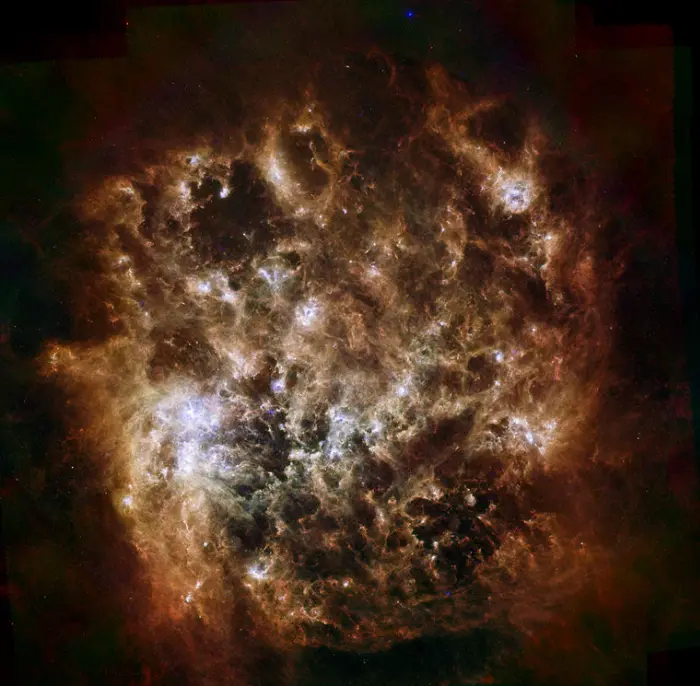
This image shows the Large Magellanic Cloud galaxy in infrared light as seen by the Herschel Space Observatory, a European Space Agency-led mission with important NASA contributions, and NASA’s Spitzer Space Telescope. Those ribbons are giant ripples of dust spanning tens or hundreds of light-years. Significant fields of star formation are noticeable in the center, just left of center and at right. The brightest center-left region is called 30 Doradus, or the Tarantula Nebula, for its appearance in visible light. The colors in this image indicate temperatures in the dust that permeates the Cloud. Colder regions show where star formation is at its earliest stages or is shut off, while warm expanses point to new stars heating surrounding dust. The coolest areas and objects appear in red, corresponding to infrared light taken up by Herschel’s Spectral and Photometric Imaging Receiver at 250 microns, or millionths of a meter. Herschel’s Photodetector Array Camera and Spectrometer fills out the mid-temperature bands, shown here in green, at 100 and 160 microns. The warmest spots appear in blue, courtesy of 24- and 70-micron data from Spitzer. Image credit: ESA/NASA/JPL-Caltech/STScI (PD)
The Large Magellanic Cloud is a Magellanic spiral galaxy, a dwarf galaxy with a single spiral arm. Magellanic spiral galaxies are intermediate between dwarf spirals and irregular galaxies. They can either have a central bar or not. The LMC has the classification SB(s)m, indicating a Magellanic barred spiral galaxy.
The stellar bar in the LMC is off-centre, indicating that the galaxy was a barred dwarf spiral before its encounter with the Small Magellanic Cloud (SMC) and the Milky Way. Tidal interactions with the two galaxies have disrupted the LMC’s spiral arms. The central bar of the LMC is warped so that its east and west ends are closer to the Milky Way that the middle section.
Distance
The Large Magellanic Cloud lies 163,000 light-years from the Sun.
The galaxy was once believed to lie at a single distance from the solar system. However, observations of the Cepheid variables in the LMC have proved otherwise. A 1986 study led by John A. R. Caldwell and Iain M. Coulson showed that Cepheids in the northeastern part of the LMC lie closer to our galaxy than those located in the southwestern portion.
Cepheid variables were used to determine the distance to the LMC. These stars have a relationship between their absolute luminosity and brightness variation period, and they are commonly used as standard candles to measure distances. Astronomers derived a distance of 160,000 light-years to the galaxy based on observations of these stars. The value was later confirmed by other studies.
In 2013, a team of astronomers found a more accurate distance of 163,000 light-years using late type eclipsing binary systems. The margin of error is only 2.2%.
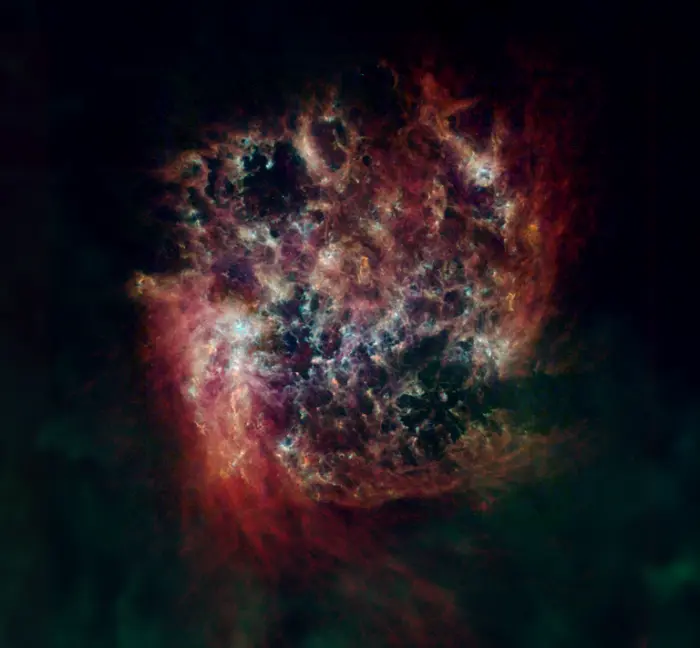
The Large Magellanic Cloud (LMC) is a satellite of the Milky Way, containing about 30 billion stars. Seen here in a far-infrared and radio view, the LMC’s cool and warm dust are shown in green and blue, respectively, with hydrogen gas in red. The image is composed of data from the European Space Agency (ESA) Herschel mission, supplemented with data from ESA’s retired Planck observatory and two retired NASA missions: the Infrared Astronomy Survey and Cosmic Background Explorer, as well as the Parkes, ATCA, and Mopra radio telescopes. Image credit: ESA, NASA, NASA-JPL, Caltech, Christopher Clark (STScI), S. Kim (Sejong University), T. Wong (UIUC)
Large Magellanic Cloud and Small Magellanic Cloud
The Large Magellanic Cloud forms a pair with the Small Magellanic Cloud (SMC), which lies 20 degrees to the west. Both are satellite galaxies of the Milky Way. The galaxies are connected by a bridge of gas and have a common envelope of neutral hydrogen. This indicates that they have been gravitationally bound for a very long time.
The Small Magellanic Cloud is an irregular dwarf galaxy located 203,700 light-years away in the constellations Tucana and Hydrus. With a diameter of 18,900 light-years, it is considerably smaller than the LMC. It contains about 3 billion stars.
The Large and Small Magellanic Clouds are linked by the Magellanic Bridge (MBR), a stream of stars and neutral hydrogen, discovered by J. V. Hindman et al. in 1963. The Magellanic Bridge should not be mistaken for the Magellanic Stream, a stream of high-velocity gas clouds that connect the two smaller galaxies with the Milky Way.
The Magellanic Stream was discovered in 1965. It stretches across 180 or more degrees of the sky, corresponding to a physical extent of 600,000 light-years. It was originally believed to lie 180,000 light-years away. In 2018, analysis of the chemical composition of the gas in the Stream confirmed that the gas probably originated in the Small Magellanic Cloud.
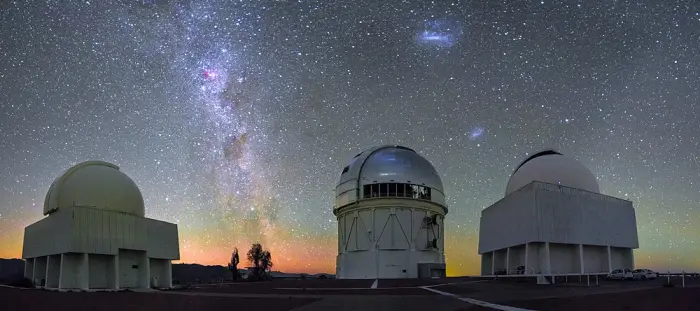
The Large and Small Magellanic Clouds – the Víctor M. Blanco 4-meter Telescope (center) with the SMARTS 1.5-meter Telescope (right) and the Curtis Schmidt Telescope (left) at Cerro Tololo Inter-American Observatory. Image credit: CTIO/NOIRLab/NSF/AURA/H. Stockebrand (CC BY 4.0)
In 2019, data obtained with the European Space Agency’s (ESA) Gaia space observatory revealed the presence of a young star cluster, Price-Whelan 1 (PW1), that belongs to the leading arm of the Magellanic Stream. The cluster was discovered by American astronomer Adrian Price-Whelan and named after him. It lies approximately 94,200 light-years away. The cluster’s existence indicates that the stream of gas extending from the LMC and the SMC to the Milky Way lies at half the distance as previously believed.
In 2006, a study published in The Astrophysical Journal proposed that the Large and Small Magellanic Clouds may not be gravitationally bound to the Milky Way. A team of astronomers led by Nitya Kallivayalil of the Harvard-Smithsonian Center for Astrophysics measured the galaxies’ proper motions and velocities through space and found that the LMC and SMC were moving at high speeds and that they were much larger than previously believed.
This could be explained by the Milky Way being more massive than previous findings suggested and pulling the smaller galaxies closer. Alternatively, it may mean that our galaxy is not massive enough to hold onto to the Magellanic Clouds and that they will escape its pull in a few billion years.
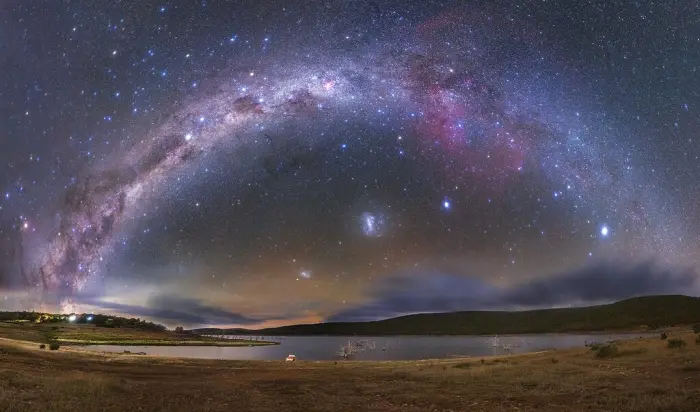
The Milky Way Over Anglers Reach, image credit: Lucy Yunxi Hu/IAU OAE (CC BY 4.0)
Constellations
The Large Magellanic Cloud lies on the border between the constellations Dorado (the Dolphinfish) and Mensa (Table Mountain). A larger part of the galaxy appears in Dorado. Some outlying objects, such as the globular cluster NGC 1466, are found in the neighbouring Hydrus (the Lesser Water Snake).
These constellations lie in the far southern sky. Dorado, the northernmost of the three, is fully visible from locations south of the latitude 20° N.
The three constellations do not have an ancient origin. They have been created since the Age of Discovery, when European navigators and astronomers started travelling to the southern hemisphere and charting the southern sky. Dorado and Hydrus were created by Dutch-Flemish astronomer Petrus Plancius in the late 16th century, and Mensa was created by French astronomer Nicolas Louis de Lacaille in the mid-18th century.
Mensa is the faintest of the three constellations. It does not contain any stars brighter than magnitude 5.0. The brightest stars in Dorado and Hydrus shine at third magnitude and do not stand out in the sky. The constellations can be identified using the Large Magellanic Cloud on a clear, dark night.
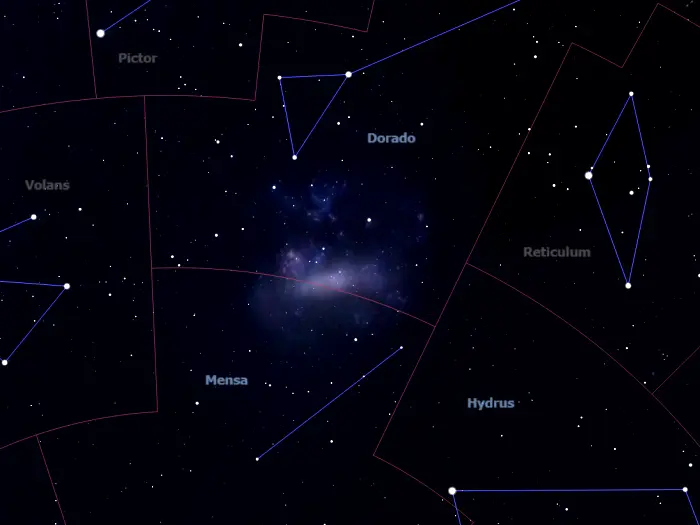
Large Magellanic Cloud in the constellations Dorado and Mensa, image: Stellarium
Objects
The Large Magellanic Cloud hosts a large number of galactic objects, including at least 700 open clusters, 60 globular clusters, and 400 planetary nebulae. The galaxy is home to countless giant and supergiant stars, as well as supernova remnants and neutron stars. It hosted the nearest supernova to Earth in recent years, SN 1987A.
The galaxy is rich in dust and gas and hosts numerous star-forming regions. The largest of these, the Tarantula Nebula, is the most active stellar nursery in the Local Group of galaxies.
Map
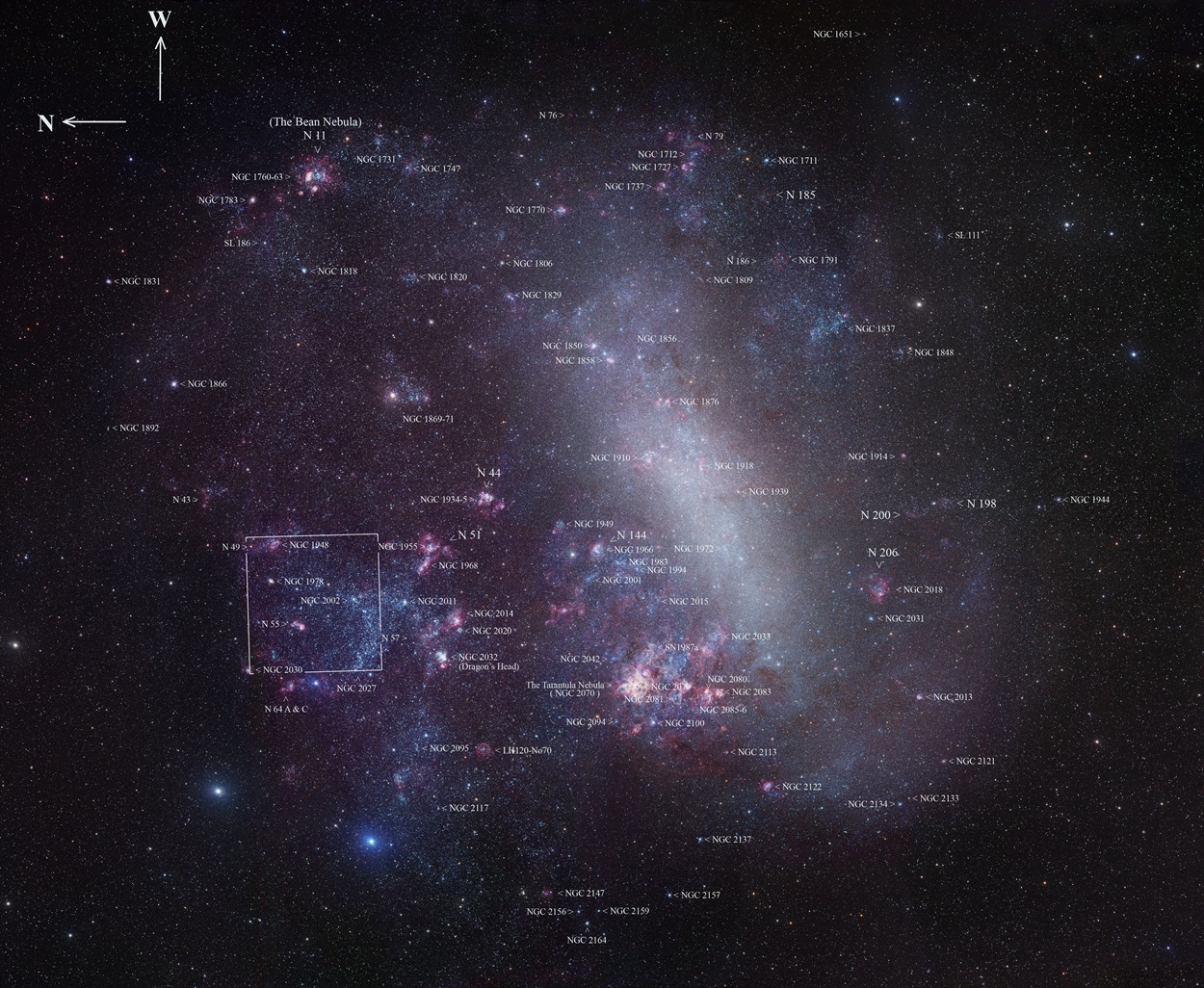
This image shows the entire Large Magellanic Cloud, with some of the brightest objects marked. The field of the new MPG/ESO 2.2-metre telescope image is indicated with an outline. The field of view is about ten degrees across. Image credit: Robert Gendler/ESO (CC BY 4.0)
Stars
The Large Magellanic Cloud contains some of the most massive and most luminous stars known. The starburst regions in the galaxy make perfect laboratories for studying the evolution of massive stars.
Many of these stars are found in and near the central star cluster of the Tarantula Nebula, NGC 2070. R136, the central condensation of NGC 2070, is home to several stars with a mass well over 100 times that of the Sun.
WOH G64
WOH G64 is a red supergiant located approximately 160,000 light-years away in the western part of the Large Magellanic Cloud. With a radius of about 1,540 solar radii, it is one of the largest stars known. If it replaced the Sun in our solar system, the behemoth star would extend past the orbit of Jupiter.
WOH G64 is surrounded by a thick envelope of dust about 1 light-year across. The dust envelope contains 3 – 9 solar masses of material expelled from the star.
The supergiant star has an effective temperature of 3,400 K and a luminosity 282,000 times that of the Sun. It has an estimated age of up to 5 million years.
The name WOH G64 comes from the names of the astronomers who discovered the star in the 1970s, the Swedish astronomers Bengt Westerlund, Nils Olander, and B. Hedin.
WOH G64 lies near the open clusters NGC 1755 and NGC 1749.
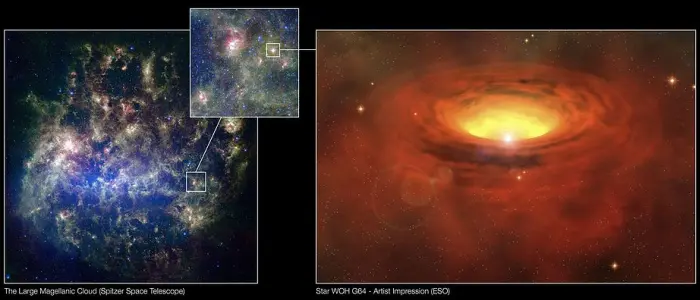
The star WOH G64. An artist’s impression is provided of the thick, massive torus of matter surrounding the star as inferred from observations made with ESO’s Very Large Telescope Interferometer. Image credit: European Southern Observatory (CC BY 4.0)
BAT99-98
BAT99-98 is a Wolf-Rayet star located near the young cluster R136 in the Tarantula Nebula. With 226 times the Sun’s mass, it may be the most massive star known.
BAT99-98 shines with a luminosity of 5 million Suns and is also one of the most luminous stars discovered to date. It has a radius 37.5 times that of the Sun and an effective temperature of 45,000 K. Due to its high temperature, most of its energy output is in the ultraviolet. Visually, the star is only 141,000 times more luminous than the Sun.
BAT99-98 has an apparent magnitude of 13.38 and lies 165,000 light-years away. It has an estimated age of 7.5 million years. Due to its high mass, it will likely meet its end as a supernova or hypernova. Alternatively, it may go out as a pair-instability supernova that does not leave behind any remnant at all.
R136a1
R136a1 is a Wolf-Rayet star located at the centre of the star cluster R136 within the larger NGC 2070 in the Tarantula Nebula. Like BAT99-98, it is one of the most massive and most luminous stars known, with a mass of about 196 solar masses and a luminosity 4,677,000 times that of the Sun.
With a radius of 42.7 solar radii, the star has a volume almost 80,000 times larger than the Sun.
R136a1 is a very young star, with an estimated age of only 1.14 million years. With a surface temperature of about 46,000 K, it is one of the hottest stars known.
R136a1 is expected to meet its end in a core-collapse supernova, leaving behind a black hole.
S Doradus
S Doradus is the prototype for a class of stars known as S Doradus stars or luminous blue variables (LBVs). With an apparent magnitude of 8.6 – 11.5, it is one of the brightest stars in the Large Magellanic Cloud and one of the few 9th magnitude stars in the galaxy. It is the brightest star in the open cluster NGC 1910 (LH41), which lies within the emission nebula N119.
S Doradus has a mass about 24 times that of the Sun and a luminosity that varies widely around 1,000,000 times that of the Sun. It is one of the most luminous stars known.
S Doradus stars are characterised by long, slow changes in visual brightness and occasional outbursts with dramatic increases in brightness. The brightness variations are accompanied by a change in colour and spectrum.
The best-known stars in this class include Eta Carinae, AG Carinae and HR Carinae in the constellation Carina, P Cygni in Cygnus, and the Godzilla star in the gravitationally lensed Sunburst galaxy in Apus. Zeta1 Scorpii and Wray 17-96 in Scorpius and the Pistol Star (V4647 Sagittarii) in Sagittarius are also candidate LBVs.
VFTS 682
VFTS 682 is a Wolf-Rayet star located 95 light-years northeast of R136, within the larger Tarantula Nebula. The star has 137.8 times the Sun’s mass and is 3.2 million times more luminous. It has an estimated surface temperature of around 54,450 K.
VFTS 682 is not a member of any cluster, which is highly unusual for a star so young. It is only about 1 million years old. It may have been ejected from R136a1.
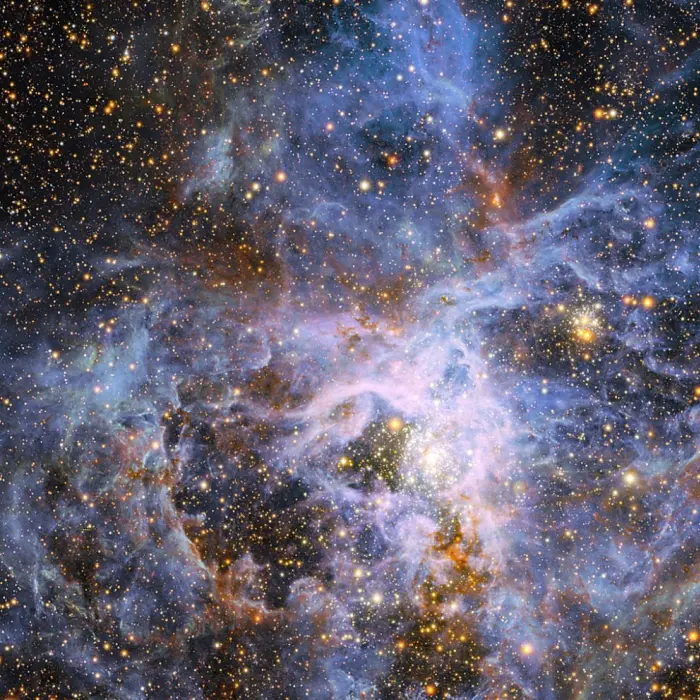
Tarantula Nebula – At the exact centre lies the brilliant but isolated star VFTS 682 and to its lower right the very rich star cluster R 136. The origins of VFTS are unclear — was it ejected from R 136 or did it form on its own? The star appears yellow-red in this view, which includes both visible-light and infrared images from the Wide Field Imager at the 2.2-metre MPG/ESO telescope at La Silla and the 4.1-metre infrared VISTA telescope at Paranal, because of the effects of dust. Image: ESO/M.-R. Cioni/VISTA Magellanic Cloud survey. Acknowledgment: Cambridge Astronomical Survey Unit (CC BY 4.0)
VFTS 352
VFTS 352 is a massive contact binary system located 164,000 light-years away in the Tarantula Nebula. The star system is composed of two stars with masses of 28.63 and 28.85 solar masses. It has an estimated age of 1 million years.
The components are similar in size, with radii 7.22 and 7.25 times that of the Sun. The primary component has a luminosity of 180,000 Suns and the secondary shines with 150,000 solar luminosities.
The two stars form one of the most massive and earliest spectral type contact binary systems known. They are tidally locked (always facing each other from the same side) and their atmospheres overlap. They take only 1.124 days to complete an orbit around the common centre of mass.
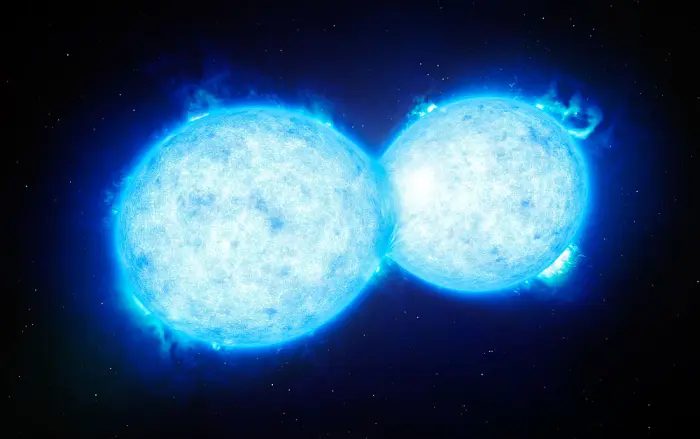
This artist’s impression shows VFTS 352 — the hottest and most massive double star system to date where the two components are in contact and sharing material. The two stars in this system lie about 160 000 light-years from Earth in the Large Magellanic Cloud. This intriguing system could be heading for a dramatic end, either with the formation of a single giant star or as a future binary black hole. Image credit: (ESO/L. Calçada) (CC BY 4.0)
VFTS 102
VFTS 102 is a hot blue O-type star located in the Tarantula Nebula, about 164,000 light-years away. With a projected rotational velocity of around 610 km/s, it is the second fastest spinning massive star known, after the Wolf-Rayet star WR 142 (1000 km/s) in the constellation Cygnus.
Due to its fast rotation, VFTS 102 has a flattened shape and experiences high mass loss in the bulging equatorial region. The expelled material forms a circumstellar disk.
VFTS 102 has a mass of 25 solar masses and shines with 100,000 solar luminosities.
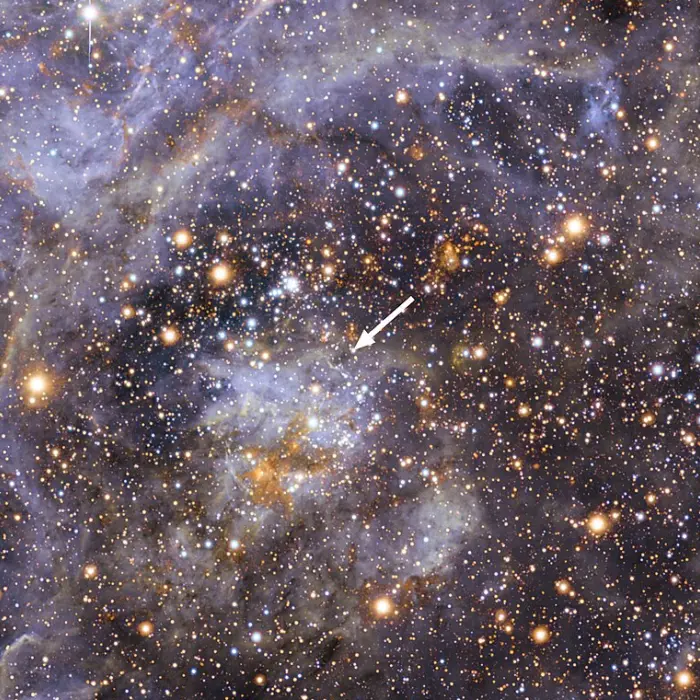
This view shows part of the stellar nursery called the Tarantula Nebula in the Large Magellanic Cloud, a small neighbour of the Milky Way. At the centre lies the brilliant star VFTS 102. This view includes both visible-light and infrared images from the Wide Field Imager at the MPG/ESO 2.2-metre telescope at La Silla and the 4.1-metre infrared VISTA telescope at Paranal. Image credit: ESO/M.-R. Cioni/VISTA Magellanic Cloud survey. Acknowledgment: Cambridge Astronomical Survey Unit (CC BY 3.0)
R71
R71 (HD 269006) is a luminous blue variable located 162,980 light-years (49,970 parsecs) away in the constellation Mensa. The star appears 3 arcminutes southwest of the yellow giant Beta Mensae, the third brightest star in Mensa (mag. 5.31).
R71 has a mass 27 times that of the Sun and a radius 107 times the Sun’s. The star’s visual brightness has been observed to vary between magnitudes 11.2 and 8.7. The luminous star experiences outbursts typical of luminous blue variables, which cause its brightness to increase.
R71 is one of the most luminous stars in the LMC. During its quiescent phase, it has a luminosity of 603,000 Suns. The star’s luminosity was observed to increase to 830,000 and 1,050,000 solar luminosities during the outbursts in 1975 and 2012.
R71 will eventually evolve into a Wolf-Rayet star and experience more dramatic outbursts until it goes out as a supernova or collapses directly to a black hole.
Supernova remnants
Many of the massive stars in the Large Magellanic Cloud have met their ends as spectacular supernovae. In 1987, the galaxy hosted the nearest supernova event observed since Kepler’s Supernova (SN 1604) in the constellation Ophiuchus. The supernova 1987A provided astronomers with the first opportunity to directly observe the radioactive source of visible light emissions in a core-collapse supernova.
SN 1987A
SN 1987A is the remnant of a type II supernova that occurred 168,000 light-years away in the Large Magellanic Cloud. The supernova became visible from Earth on February 23, 1987. It peaked at magnitude 3 and was the first supernova visible to the unaided eye since the invention of the telescope.
The progenitor star, Sanduleak -69 202 (Sk -69 202), was a blue supergiant of the spectral type B3Ia. The supergiant was located on the outskirts of the Tarantula Nebula. It had a mass of about 20 solar masses and a luminosity of 100,000 Suns.
The evidence for the presence of the neutron star left in the wake of the supernova was not discovered until 2019, when observations with the Atacama Large Millimeter Array (ALMA) provided indirect evidence for a pulsar wind nebula.
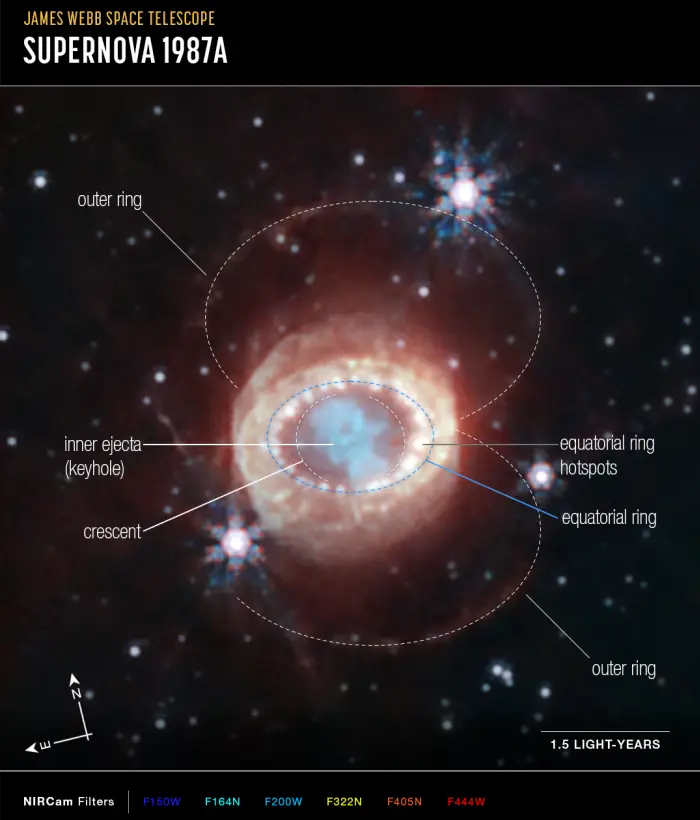
Webb’s NIRCam (Near-Infrared Camera) captured this detailed image of SN 1987A (Supernova 1987A), which has been annotated to highlight key structures. At the center, material ejected from the supernova forms a keyhole shape. Just to its left and right are faint crescents newly discovered by Webb. Beyond them an equatorial ring, formed from material ejected tens of thousands of years before the supernova event, contains bright hot spots. Exterior to that is diffuse emission and two faint outer rings. In this image blue represents light at 1.5 microns (F150W), cyan 1.64 and 2.0 microns (F164N, F200W), yellow 3.23 microns (F323N), orange 4.05 microns (F405N), and red 4.44 microns (F444W). Image credit: NASA, ESA, CSA, Mikako Matsuura (Cardiff University), Richard Arendt (NASA-GSFC, UMBC), Claes Fransson (Stockholm University), Josefin Larsson (KTH); Image processing: Alyssa Pagan (STScI)
Honeycomb Nebula
The Honeycomb Nebula is a supernova remnant located about 150,000 light-years away in the Large Magellanic Cloud. It was discovered during observations of the supernova SN 1987A with ESO’s New Technology Telescope in the early 1990s.
Astronomers believe that the Honeycomb Nebula is in fact formed by remnants of two supernovae, an older expanding shell of material and a more recent remnant piercing the older one.
The Honeycomb Nebula has a radius of 37.1 light-years and an apparent size of 1.70 by 1.70 arcminutes.
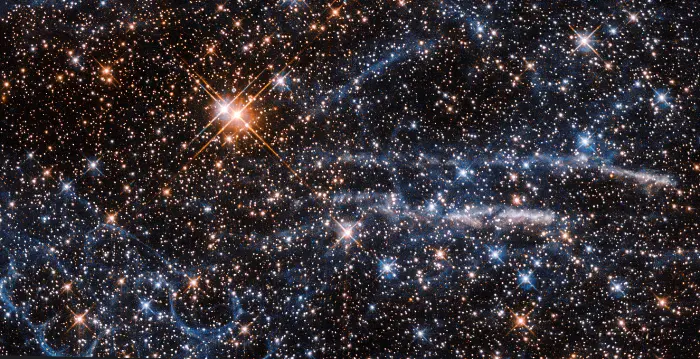
The Honeycomb Nebula was found serendipitously by astronomers using ESO’s New Technology Telescope to image the nearby SN1987A, the closest observed supernova to Earth for over 400 years. The nebula’s strange bubble-like shape has baffled astronomers since its discovery in the early 1990s. Various theories have been proposed to explain its unique structure, some more exotic than others. Image credit: ESA/Hubble & NASA; Acknowledgments: Judy Schmidt (Geckzilla) (CC BY 2.0)
Brazil Nebula (N49)
LMC N49 (DEM L 190) is the remnant of a supernova event that occurred about 5,000 years ago. With an apparent magnitude of 12.71, it is the brightest supernova remnant in the Large Magellanic Cloud. It was discovered on March 5, 1979.
The remnant is 75 light-years across. It was nicknamed the Brazil Nebula because of its resemblance to Brazil as it appears on a map.
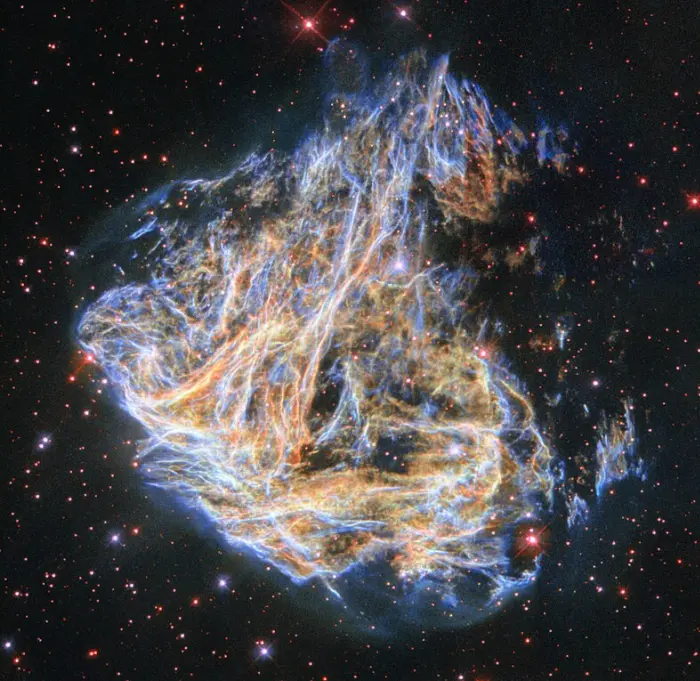
Shreds of the luridly coloured supernova remnant DEM L 190 seem to billow across the screen in this image from the NASA/ESA Hubble Space Telescope. The delicate sheets and intricate filaments are debris from the dramatic end of a massive star that once lived in the Large Magellanic Cloud. Image credit: ESA/Hubble & NASA, S. Kulkarni, Y. Chu (CC BY 4.0)
SNR 0509-67.5
SNR 0509-67.5 is believed to be a remnant of a type Ia supernova. These supernovae are triggered by a white dwarf accreting too much mass from a binary companion or by two white dwarfs colliding. The remnant has been imaged at X-ray and visible wavelengths.
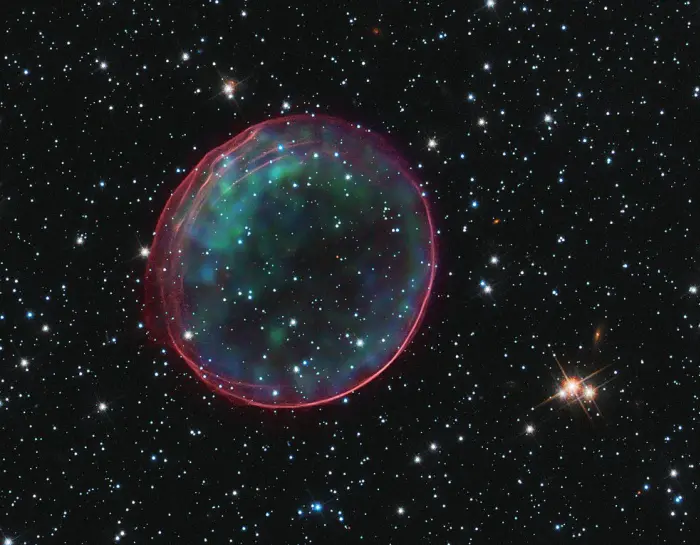
Combined photos of SNR B0509-67.5 made by HST and Chandra space telescopes. Credit: NASA, ESA, and the Hubble Heritage Team (STScI/AURA). Acknowledgement: J. Hughes (Rutgers University) (PD)
N63A
The supernova remnant N63A (LMC N 63A) has an estimated age of 2,000 to 5,000 years. It is one of the many remnants in the Large Magellanic Cloud that have captured by NASA and ESA’s Hubble Space Telescope, as well as by the Chandra X-ray Observatory.
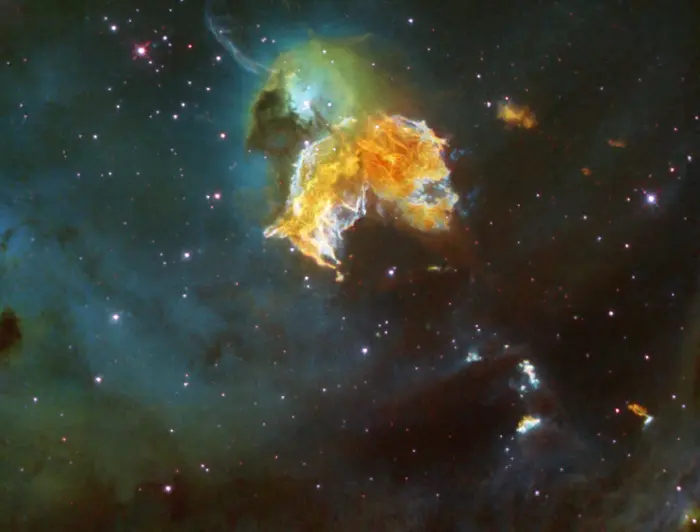
N63A by the Hubble Space Telescope, image credit: NASA, ESA, HEIC, and the Hubble Heritage Team STScI/AURA). Acknowledgment: Y.-H. Chu and R. M. Williams (UIUC) (CC BY 4.0)
SNR 0540-69.3
SNR 0540-69.3 is the remnant of a supernova that occurred in the Large Magellanic Cloud between 350 and 1250 CE.
The supernova remnant is associated with the pulsar PSR J0540−6919, the first extragalactic gamma-ray pulsar discovered. The high-energy radiation and strong magnetic field of the pulsar energize the surrounding nebula.
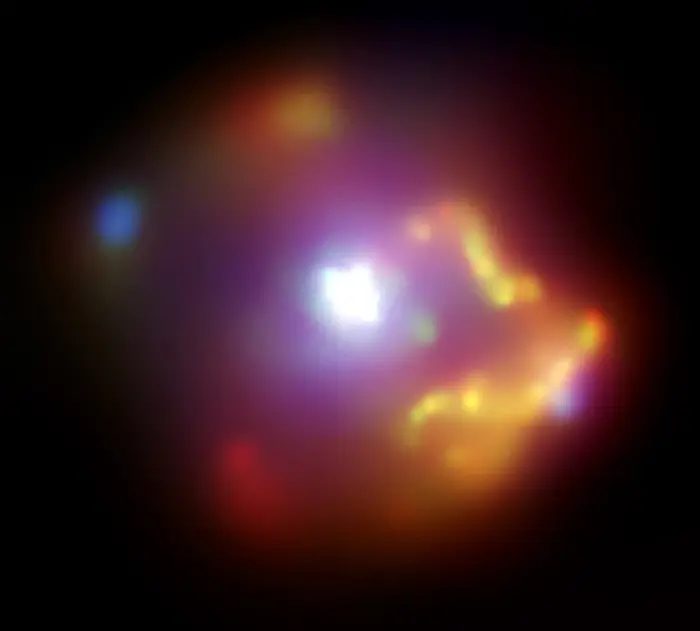
SNR 0540-69.3 by the Chandra X-ray Observatory, image credit: Smithsonian Institution, NASA/CXC/SAO (CC0 1.0)
SNR E0519-69.0
SNR E0519-69.0 is the remnant of a white dwarf that accreted too much material from a binary companion. The expanding shell of material is more than 30 light-years wide. The supernova remnant has an estimated age of about 600 years.
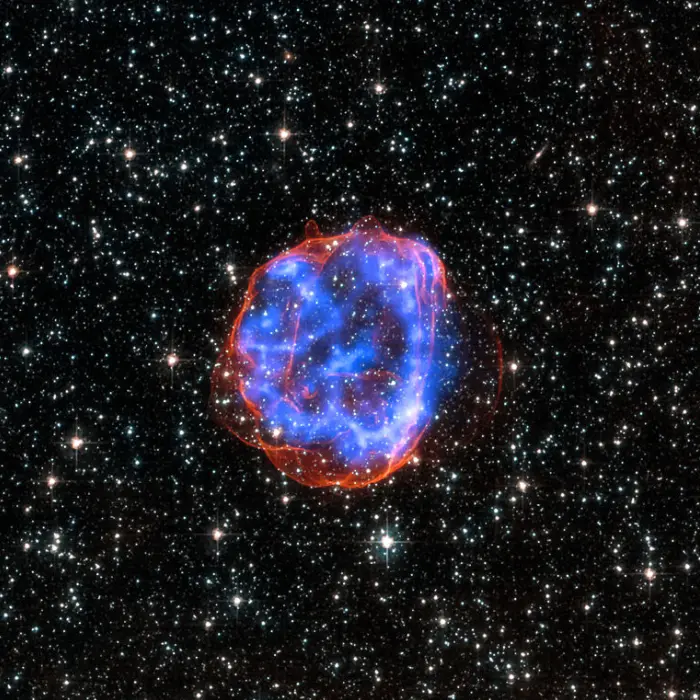
X-ray & Optical Images of SNR E0519-69.0 – When a massive star went out as a supernova in the Large Magellanic Cloud, a satellite galaxy to the Milky Way, it left behind an expanding shell of debris called SNR 0519-69.0. Here, multimillion degree gas is seen in X-rays from Chandra (blue). The outer edge of the supernova remnant (red) and stars in the field of view are seen in visible light from Hubble. Image credit – X-ray: NASA/CXC/Rutgers/J.Hughes; Optical: NASA/STScI (PD)
DEM L71
DEM L71 is the remnant of a type Ia supernova that occurred about 4,000 years ago in the Large Magellanic Cloud. It formed when a white dwarf became unstable and ignited.
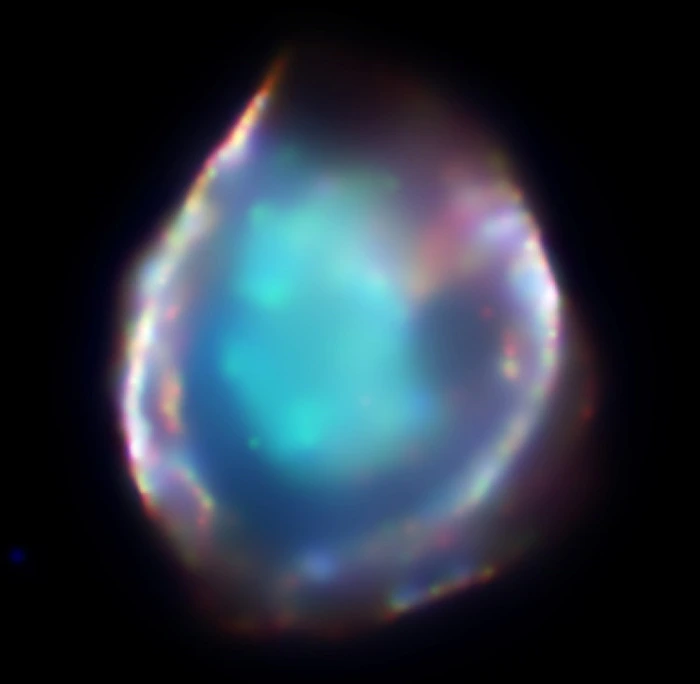
Chandra’s X-ray image of the supernova remnant DEM L71 revealed a ten million-degree hot inner cloud (aqua) of glowing iron and silicon surrounded by an outer ring of 5 million-degree gas. An analysis of the Chandra data identified the inner cloud as the remains of a white dwarf star that went out as a supernova. Image credit: Smithsonian Institution (CC0 1.0)
Nebulae
The Large Magellanic Cloud contains many star forming regions that host very young star clusters. The H II regions in the galaxy are often studied by astronomers looking for insights into stellar formation and evolution. The proximity of these active stellar nurseries makes them ideal targets for ground-based and space telescopes. Many of them, including the bright, large Tarantula Nebula, offer clues into the star formation in the Milky Way billions of years ago, when our galaxy churned out more new stars than it does today.
The star forming nebulae in the LMC are energized by the strong ultraviolet radiation from the young, luminous stars that formed within them.
Tarantula Nebula (30 Doradus)
The Tarantula Nebula (30 Doradus) is the largest and most active of the many star-forming regions in the Large Magellanic Cloud. From our perspective, it forms the southeastern corner of the LMC. The nebula has an apparent magnitude of 8 and an apparent size of 40 by 25 arcminutes.
The Tarantula is an exceptionally luminous object. It if lay at the same distance as the better-known Orion Nebula in the equatorial constellation of Orion, it would occupy a good portion of the sky and cast shadows in the daytime.
30 Doradus may be the largest star forming region in the Local Group of galaxies. Only NGC 604 in the Triangulum Galaxy may be even larger.
The young star cluster NGC 2070 lies at the centre of the Tarantula. The cluster contains a central condensation, R136, that harbours some of the most massive and most luminous stars known, including the Wolf-Rayet stars R136a1, R136a2, and R136a3. The stars of R136 have an estimated age of only 1.5 million years.
The Tarantula Nebula also hosts the older open clusters NGC 2060 and Hodge 301. NGC 2060 is 10 million years old, and Hodge 301 has an estimated age of 20 – 25 million years.
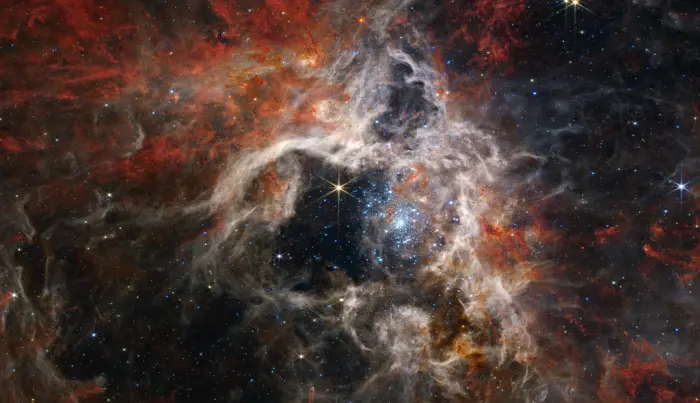
In this mosaic image stretching 340 light-years across, Webb’s Near-Infrared Camera (NIRCam) displays the Tarantula Nebula star-forming region in a new light, including tens of thousands of never-before-seen young stars that were previously shrouded in cosmic dust. The most active region appears to sparkle with massive young stars, appearing pale blue. Scattered among them are still-embedded stars, appearing red, yet to emerge from the dusty cocoon of the nebula. NIRCam is able to detect these dust-enshrouded stars thanks to its unprecedented resolution at near-infrared wavelengths. To the upper left of the cluster of young stars, and the top of the nebula’s cavity, an older star prominently displays NIRCam’s distinctive eight diffraction spikes, an artefact of the telescope’s structure. Following the top central spike of this star upward, it almost points to a distinctive bubble in the cloud. Young stars still surrounded by dusty material are blowing this bubble, beginning to carve out their own cavity. Astronomers used two of Webb’s spectrographs to take a closer look at this region and determine the chemical makeup of the star and its surrounding gas. This spectral information will tell astronomers about the age of the nebula and how many generations of star birth it has seen. Farther from the core region of hot young stars, cooler gas takes on a rust colour, telling astronomers that the nebula is rich with complex hydrocarbons. This dense gas is the material that will form future stars. As winds from the massive stars sweep away gas and dust, some of it will pile up and, with gravity’s help, form new stars. Image credit: NASA, ESA, CSA, and STScI (CC BY 4.0)
Ghost Head Nebula (NGC 2080)
The Ghost Head Nebula (NGC 2080) is one of the several smaller emission nebulae located south of the Tarantula Nebula. It stretches 50 light-years across.
The Ghost Head contains very young stars that formed within the last 10,000 years. These young stellar objects are still hidden in their birth dust clouds.
The nebula has two distinct bright patches, nicknamed the “eyes of the ghost.” These patches are formed by the young stars born within the nebula.
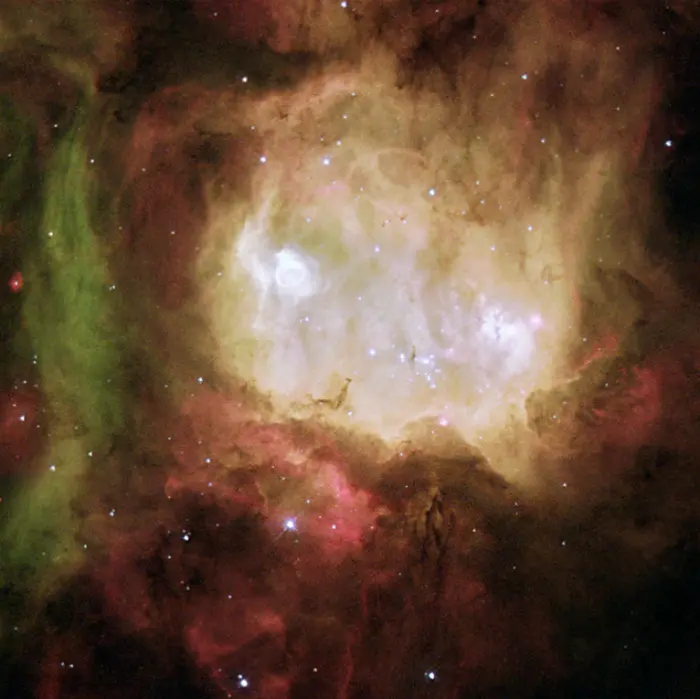
Looking like a colorful holiday card, this image from NASA’s Hubble Space Telescope reveals a vibrant green and red nebula far from Earth, where nature seems to have put on the traditional colors of the season. These colors, produced by the light emitted by oxygen and hydrogen, help astronomers investigate the star-forming processes in nebulas such as NGC 2080. NGC 2080, nicknamed “The Ghost Head Nebula,” is one of a chain of star-forming regions lying south of the 30 Doradus nebula in the Large Magellanic Cloud that have attracted special attention. These regions have been studied in detail with Hubble and have long been identified as unique star-forming sites. 30 Doradus is the largest star-forming complex in the whole local group of galaxies. The light from the nebula captured in this image is emitted by two elements, hydrogen and oxygen. The red and the blue light are from regions of hydrogen gas heated by nearby stars. The green light on the left comes from glowing oxygen. The energy to illuminate the green light is supplied by a powerful stellar wind (a stream of high-speed particles) coming from a massive star just outside the image. The white region in the center is a combination of all three emissions and indicates a core of hot, massive stars in this star-formation region. The intense emission from these stars has carved a bowl-shaped cavity in the surrounding gas. Image credit: ESA, NASA, & Mohammad Heydari-Malayeri (Observatoire de Paris, France) (PD)
NGC 2014 and NGC 2020
The nebulae NGC 2014 and NGC 2020 form a contrasting pair within a larger star-forming region in the Large Magellanic Cloud. NGC 2014 is an emission nebula associated with an open star cluster. It appears red in images. The stars in the nebula are 10 – 20 times more massive than the Sun. Their ultraviolet radiation heats and excites the surrounding nebular gas.
The blue nebula NGC 2020 is an H II region associated with the massive Wolf-Rayet star BAT99-59. The nebula was produced by the star, which gradually shed its material in a series of eruptions that have left it without a portion of its outer envelope. The central star has a luminosity of 200,000 Suns.
The two nebulae have been nicknamed the Cosmic Reef because their appearance evokes an undersea world.
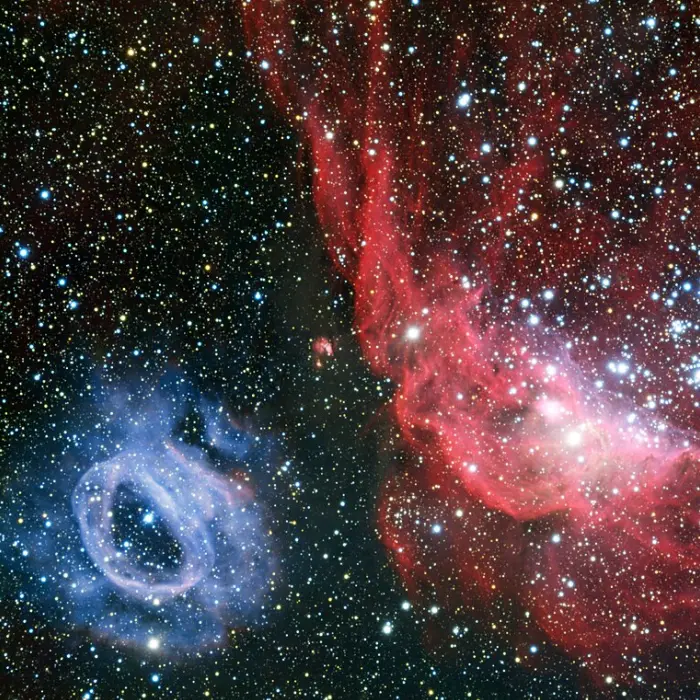
ESO’s Very Large Telescope has captured a detailed view of a star-forming region in the Large Magellanic Cloud — one of the Milky Way’s satellite galaxies. This sharp image reveals two glowing clouds of gas. NGC 2014 (right) is irregularly shaped and red and its neighbour, NGC 2020, is round and blue. These odd and very different forms were both sculpted by powerful stellar winds from exceptionally hot newborn stars that also radiate into the gas, causing it to glow brightly. Image: ESO (CC BY 4.0)
N44
N44 is a large emission nebula that stretches about 1,000 light-years across. It has a superbubble structure with a smaller bubble inside.
The nebula contains a young cluster near its centre. The radiation pressure of about 40 of the cluster members have produced the nebula’s superbubble structure.
A smaller bubble, designated N44F, was created by a massive central star whose stellar wind has a velocity of 7 million kilometres per hour.
N44 contains the smaller emission nebulae NGC 1935 and NGC 1936 and the star cluster NGC 1929. NGC 1929 is 0.8 arcminutes across and has an apparent magnitude of 14.0.
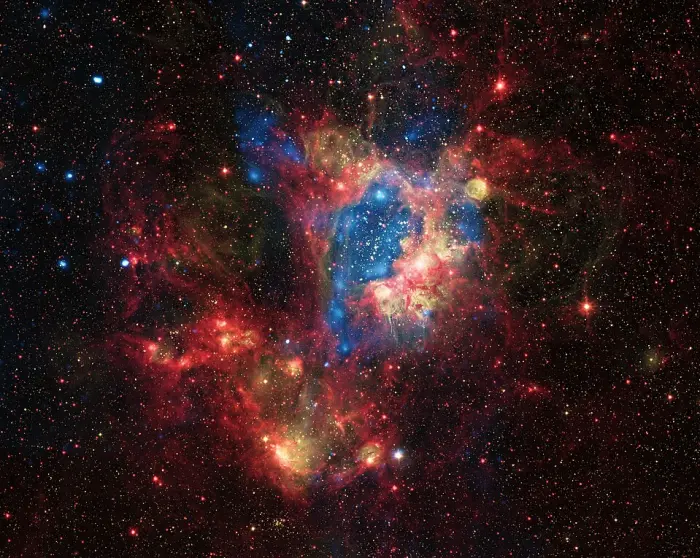
This colourful new view shows the star-forming region LHA 120-N44 [1] in the Large Magellanic Cloud, a small satellite galaxy of the Milky Way. This picture combines the view in visible light from the MPG/ESO 2.2-metre telescope at ESO’s La Silla Observatory in Chile with images in infrared light and X-rays from orbiting satellite observatories. At the centre of this very rich region of gas, dust and young stars lies the star cluster NGC 1929. Its massive stars produce intense radiation, expel matter at high speeds as stellar winds, and race through their short but brilliant lives to go out as supernovae. The winds and supernova shock waves have carved out a huge cavity, called a superbubble, in the surrounding gas. Image credit – Optical: ESO, X-ray: NASA/CXC/U.Mich./S.Oey, IR: NASA/JPL (CC BY 3.0)
NGC 1935 and NGC 1936
NGC 1935 and NGC 1936 are emission nebulae located within the larger LMC-N44 region of the Large Magellanic Cloud. The nebulae were discovered by English astronomer John Herschel in 1834.
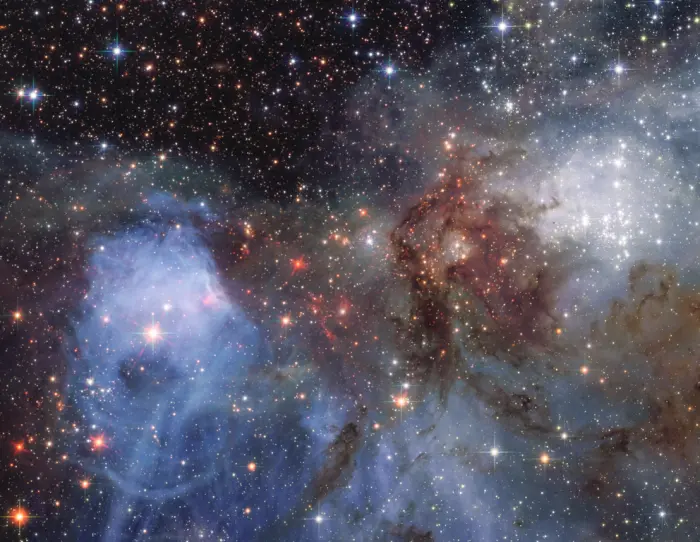
Colorful stars and clouds of gas and dust in visible and near-infrared light. The bright, blueish cloud on the left is NGC 1936, and the bright, white cluster of stars and cloud on the right is NGC 1935. These two objects are a particularly beautiful part of a larger structure referred to as LHA 120-N44, or N44 for short, which is a star-forming region in the Large Magellanic Cloud. N44 is described as a superbubble due to the void it has cleared away at its center, visible as the dark patch at the upper left of the image. The dusty brown cloud in the middle is full of little red dots which are young stellar objects or dust-obscured stars. Image credit: Judy Schmidt (CC BY 2.0)
N11
N11 (LMC N11, LHA 120-N 11) is a large emission nebula in the northwestern part of the Large Magellanic Cloud. It is the brightest nebula in this part of the LMC and the second largest H II region in the galaxy, after the Tarantula Nebula.
N11 stretches across 6 arcminutes of the apparent sky and has a physical radius of 500 light-years. It consists of a huge bubble and nine large nebulae that surround the bubble.
The star-forming region contains a large cavity and a central cluster, NGC 1761. A supernova remnant, N11L, also resides in the nebula.
The brightest nebula within the region is NGC 1763, also called the Bean Nebula. The nebula appears in the northern portion of N11, designated N11B. The Bean Nebula is an emission nebula that contains an embedded cluster. It is 3 by 5 arcminutes across.
Two other emission nebulae appear to the east. The Rose Nebula (N11A, IC 2116) appears on the northeastern edge and the emission nebula NGC 1769 (N11C) lies on the eastern side of N11. The latter is associated with at least two open star clusters.
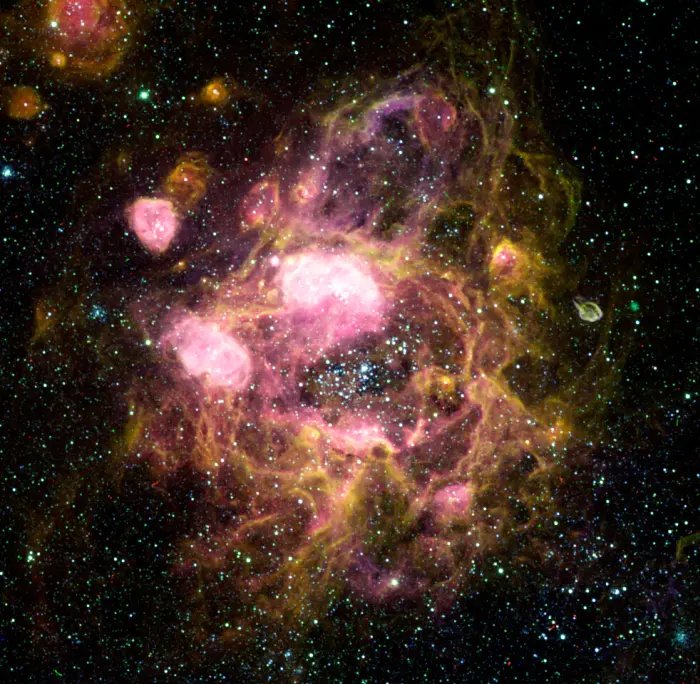
An image of N11 in the Large Magellanic Cloud, taken with the Curtis Schmidt telescope at Cerro Tololo Inter-American Observatory (CTIO) as part of the Magellanic Clouds Emission-Line Survey (MCELS). Credit: C. Aguilera, C. Smith and S. Points/NOIRLab/NSF/AURA (CC BY 4.0)
N119
N119 (LHA 120-N 119) is a large H II region with an unusual S-shaped structure. The region is home to the luminous blue variable S Doradus and several other luminous stars, including the Wolf-Rayet stars LH41-1042 and LMC195-1. S Doradus lies within DEM L132a, one of the several bubble-shaped nebulae in the region.
N119 is 430 by 570 light-years across and lies north of the LMC’s stellar bar. It is associated with the open cluster NGC 1910. S Doradus is the brightest member of the cluster.
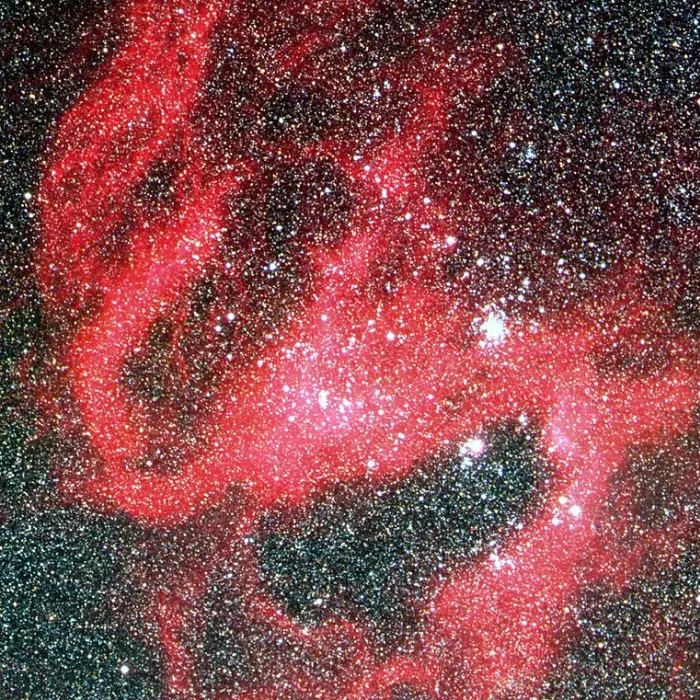
This image shows N119 in detail. N119 is an “H II region” in the LMC. The most remarkable characteristic is its pronounced spiral shape that is reminiscent of a barred spiral galaxy. It is quite large, about 400 x 600 light-years, and it is situated at the northern side of the stellar bar of the Large Magellanic Cloud, near the centre of rotation of the neutral hydrogen in this galaxy. It is this bar that is responsible for the much higher star density in the lower half of the full-field photo. Image: ESO (CC BY 4.0)
N55
N55 (LHA 120-N 55) is an emission nebula 7 by 5 arcminutes across in the Large Magellanic Cloud. It lies within the superbubble LMC 4. Astronomers have detected numerous molecular clumps inside the nebula. At least 15 of these harbour young stellar objects. The nebula lies 160,000 light-years away.
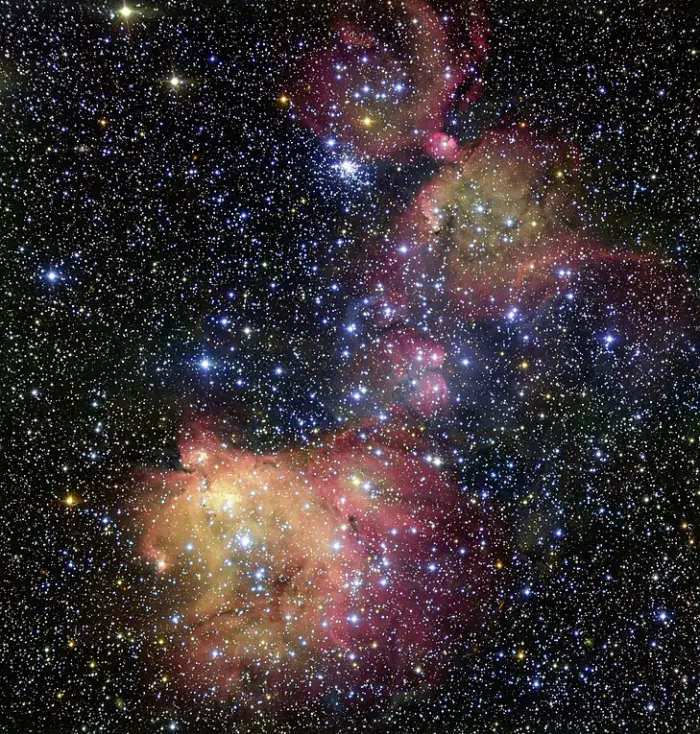
In this image from ESO’s Very Large Telescope (VLT), light from blazing blue stars energises the gas left over from the stars’ recent formation. The result is a strikingly colourful emission nebula, called LHA 120-N55, in which the stars are adorned with a mantle of glowing gas. Astronomers study these beautiful displays to learn about the conditions in places where new stars develop. Credit: ESO (CC BY 4.0)
LH 95
LH 95 is a star forming nebula associated with N55. Observations with the Hubble Space Telescope have revealed more than 2,500 pre-main sequence stars in the nebula. These are mostly low-mass stars, with masses as low as 30% that of the Sun.
The nebula has an apparent magnitude of 11.10 and an apparent size of 0.80 by 0.65 arcminutes. It lies approximately 163,000 light-years away.
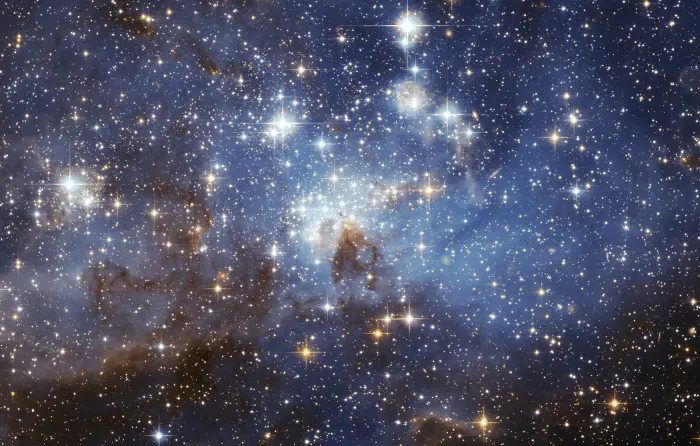
LH 95 by he Hubble Space Telescope, credit: European Space Agency (ESA/Hubble) (CC BY 4.0)
N79
N79 is a large star forming nebula in the southwestern part of the Large Magellanic Cloud. In the past 500,000 years, the rate of star formation in the nebula has exceeded that of the Tarantula Nebula. The nebula contains a luminous infrared compact source that may be a precursor to R136 in the Tarantula.
N79 has a diameter of 1,630 light-years and is considered to be a younger version of the Tarantula. Like the Tarantula, N79 was imaged by NASA and ESA’s James Webb Space Telescope (JWST).
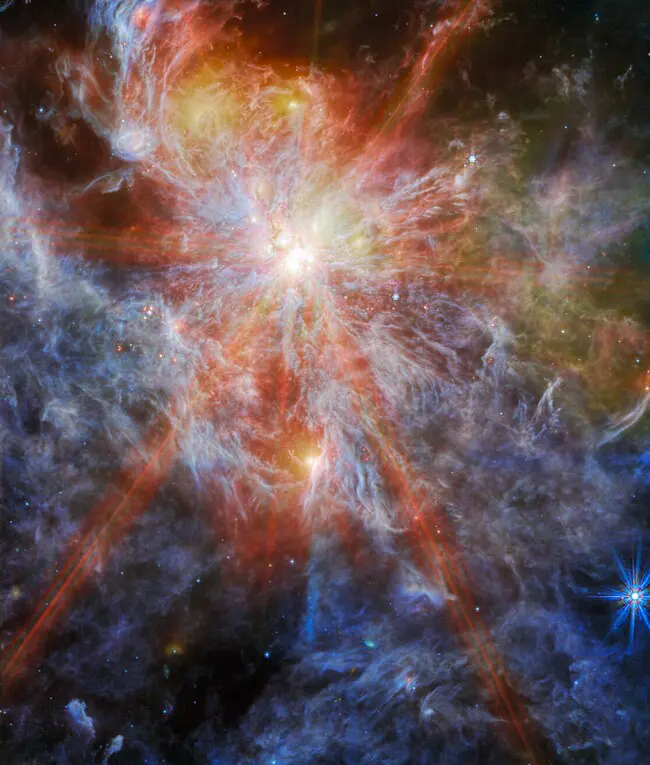
This image from the NASA/ESA/CSA James Webb Space Telescope features an H II region in the Large Magellanic Cloud (LMC), a satellite galaxy of our Milky Way. This nebula, known as N79, is a region of interstellar atomic hydrogen that is ionised, captured here by Webb’s Mid-InfraRed Instrument (MIRI).N79 is a massive star-forming complex spanning roughly 1630 light-years in the generally unexplored southwest region of the LMC. Image credit: ESA/Webb, NASA & CSA, O. Nayak, M. Meixner (CC BY 4.0)
Dragon’s Head Nebula
The Dragon’s Head Nebula is an H II region located north of the LMC’s main bar. The name is shared by two neighbouring emission nebulae, NGC 2035 and NGC 2029. The nebulae are part of a complex that also includes the supernova remnant NGC 2040 with an open cluster and the Seagull Nebula (NGC 2032).
NGC 2035 has an apparent size of 3 arcminutes and NGC 2029 is 2.25 arcminutes across.
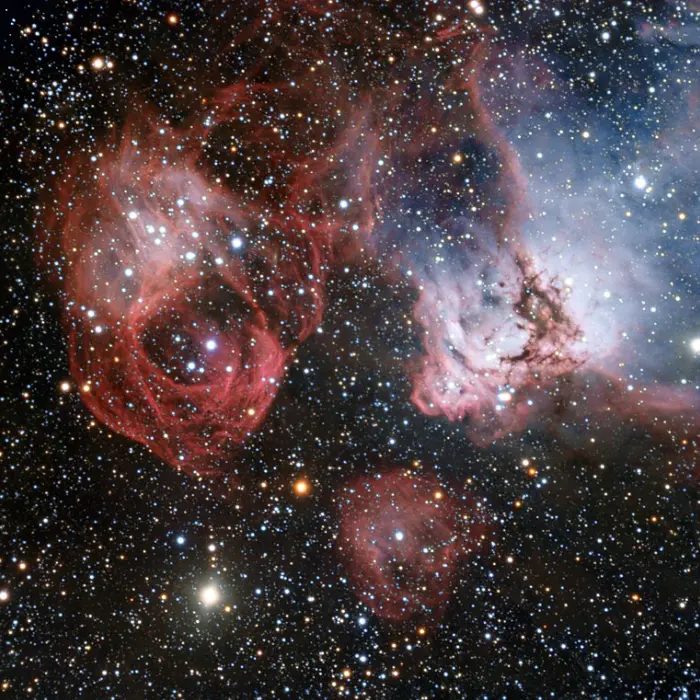
The Large Magellanic Cloud is one of the closest galaxies to our own. Astronomers have now used the power of the ESO’s Very Large Telescope to explore NGC 2035, one of its lesser known regions, in great detail. This new image shows clouds of gas and dust where hot new stars are being born and are sculpting their surroundings into odd shapes. But the image also shows the filaments created by a supernova event (left). Image credit: ESO (CC BY 4.0)
Henize 70
Henize 70 (N70, LHA 120-N 70) is an emission nebula and superbubble 7 by 8 arcminutes across. The faint H II region is shaped by the luminous O and B-type stars of the LH114 OB association. It may have formed in a supernova event, but its origin is uncertain. The nebula is about 300 light-years across.
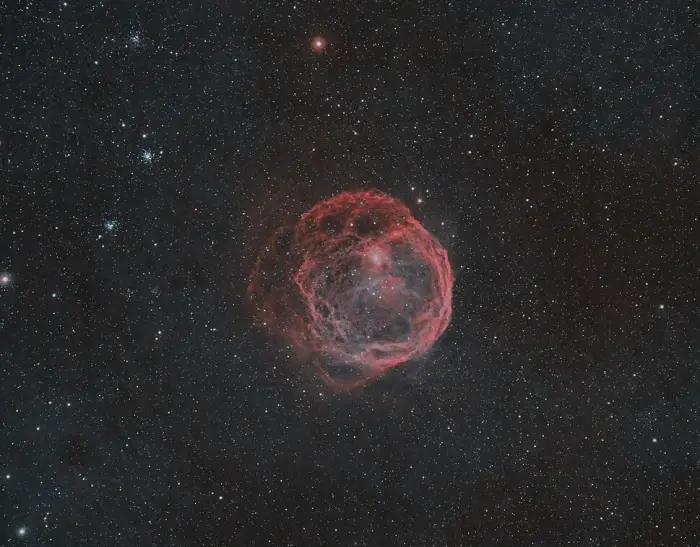
Henize 70, image credit: Dylan O’Donnell (CC0 1.0)
Henize 206
Henize 206 (LHA 120-N 206) is an H II region believed to have originated in a supernova event. It is associated with the cluster NGC 2018. The nebula has an apparent size of 3.20 arcminutes. It hosts hundreds, possibly even thousands of stars with an estimated age of 2 – 10 million years.
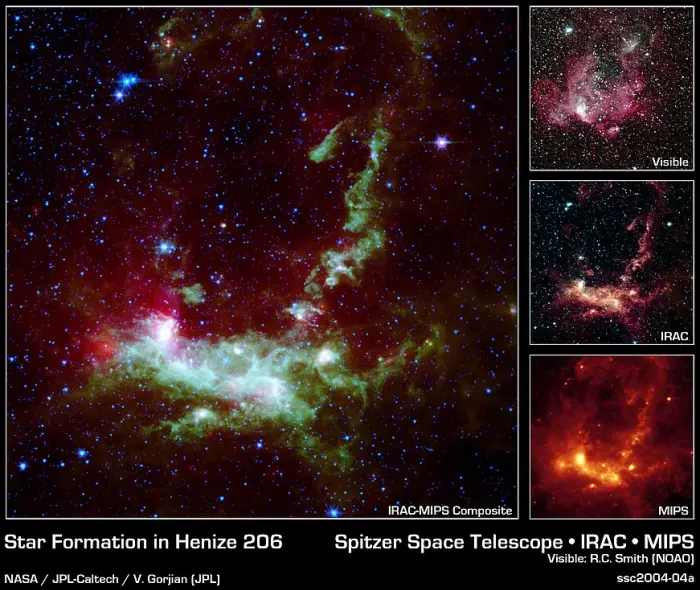
Within the Large Magellanic Cloud (LMC), a nearby and irregularly-shaped galaxy seen in the Southern Hemisphere, lies a star-forming region heavily obscured by interstellar dust. NASA’s Spitzer Space Telescope has used its infrared eyes to poke through the cosmic veil to reveal a striking nebula where the entire lifecycle of stars is seen in splendid detail. Image credit: NASA/JPL-Caltech/V. Gorjian (JPL) (PD)
N159
N159 is a turbulent stellar nursery located 170,000 light-years away in the Large Magellanic Cloud. It is more than 150 light-years across and lies just south of the larger Tarantula Nebula.
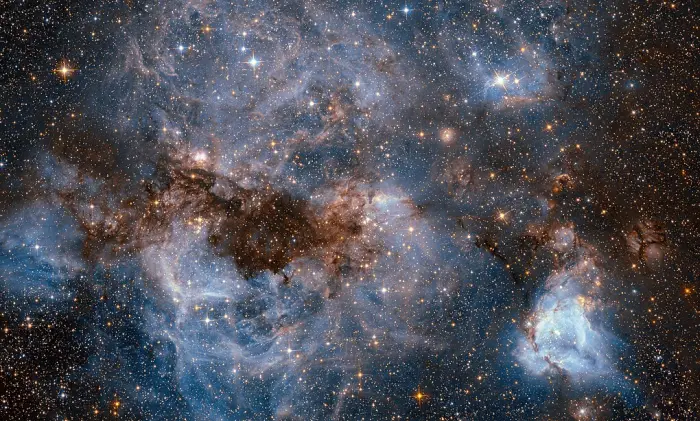
This shot from the NASA/ESA Hubble Space Telescope shows a maelstrom of glowing gas and dark dust within one of the Milky Way’s satellite galaxies, the Large Magellanic Cloud (LMC). This stormy scene shows a stellar nursery known as N159, an HII region over 150 light-years across. N159 contains many hot young stars. These stars are emitting intense ultraviolet light, which causes nearby hydrogen gas to glow, and torrential stellar winds, which are carving out ridges, arcs, and filaments from the surrounding material. At the heart of this cosmic cloud lies the Papillon Nebula, a butterfly-shaped region of nebulosity. This small, dense object is classified as a High-Excitation Blob, and is thought to be tightly linked to the early stages of massive star formation. Credit: ESA/Hubble & NASA (CC BY 2.0)
LH 72
LH 72 is one of the largest stellar nurseries in the Large Magellanic Cloud. It contains a young OB association of massive, luminous blue stars. The stars have an estimated age of 5 – 15 million years. The nebula lies within a large supershell, LMC4, that is 6,000 light-years across.
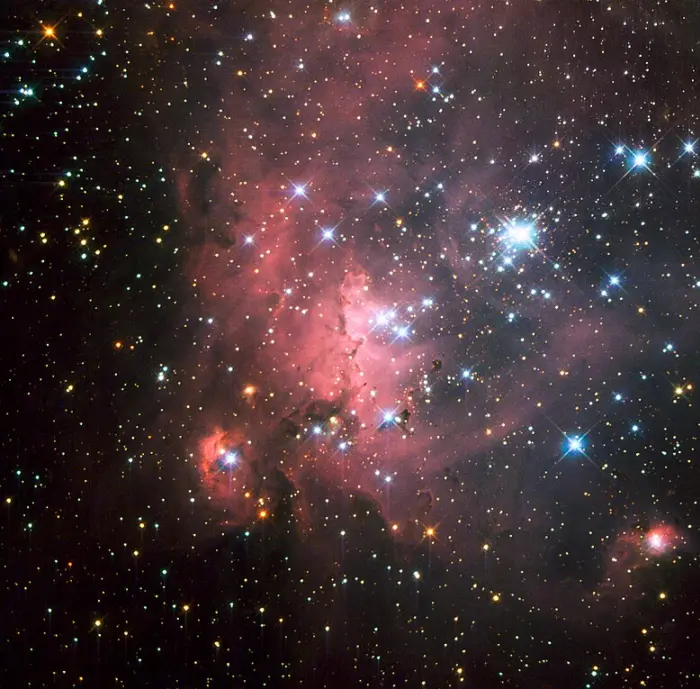
In one of the largest known star formation regions in the Large Magellanic Cloud (LMC), a small satellite galaxy of the Milky Way, lie young and bright stellar groupings known as OB associations. One of these associations, called LH 72, was captured in this dramatic NASA/ESA Hubble Space Telescope image. It consists of a few high-mass, young stars embedded in a beautiful and dense nebula of hydrogen gas. Image credit: ESA/Hubble, NASA and D. A. Gouliermis (CC BY 3.0)
Open clusters
The Large Magellanic Cloud has a rich population of open clusters. Astronomers have discovered at least 700 of these objects in the galaxy. Many of the brighter clusters were discovered by the English astronomer John Herschel from South Africa and the Scottish astronomer James Dunlop from Australia in the 19th century.
NGC 2070
NGC 2070 (Caldwell 103) is a bright, large open cluster that lies at the centre of the Tarantula Nebula. The cluster has an apparent magnitude of 7.25 and is 3.50 arcminutes across. It can be observed in small telescopes. Its members produce most of the energy that makes the surrounding nebula visible.
NGC 2070 contains a central condensation, designated R136, which is home to some of the most massive and most luminous stars known.
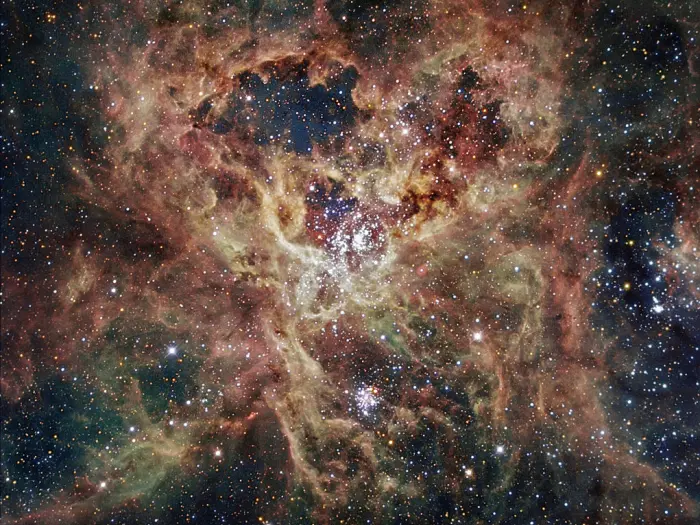
NGC 2070, image credit: ESO (CC BY 4.0)
R136
R136 is an exceptionally massive and dense open cluster with an apparent magnitude of 9.50. Even though it is massive, its stars are still very young and none of them have gone out as supernovae. The cluster has an estimated age of only 1.5 million years.
The Wolf-Rayet star R136a1, the brightest member of R136, has a mass 196 times that of the Sun and is 4,677,000 times more luminous than the Sun. Along with its Tarantula Nebula neighbours BAT99-98 and Melnick 42, it is one of the most massive stars known. About a dozen other members of R136 have a mass of around 100 solar masses or more.
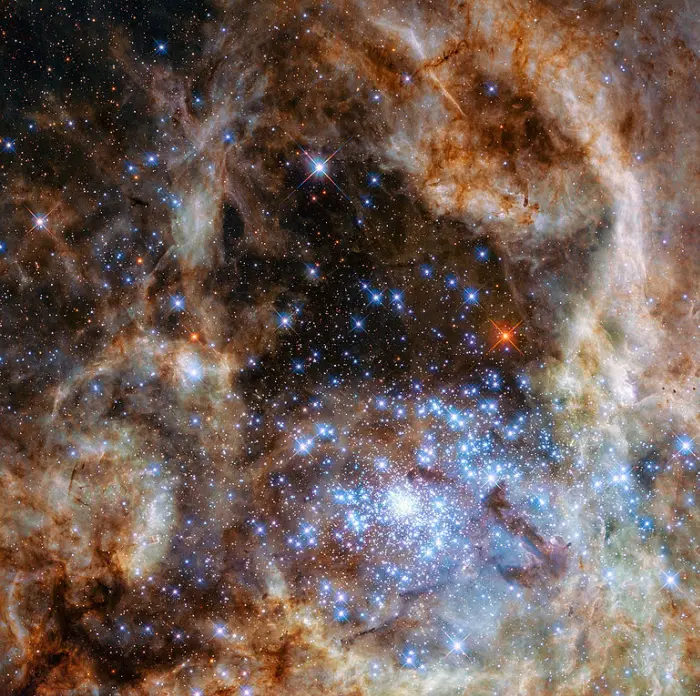
A Hubble Space Telescope image of the R136 super star cluster, near the center of the 30 Doradus Nebula, also known as the Tarantula Nebula or NGC 2070. Image credit: NASA, ESA, F. Paresce (INAF-IASF, Bologna, Italy), R. O’Connell (University of Virginia, Charlottesville), and the Wide Field Camera 3 Science Oversight Committee
NGC 2060
NGC 2060 is one of the several major clusters in the Tarantula Nebula. It has an estimated age of about 10 million years. It is associated with the supernova remnant N157B (30 Doradus B).
The supernova occurred around 5,000 years ago and produced a pulsar, PSR J0537-6910, with a very fast rotation period (16 milliseconds). The O-type main sequence star VFTS 102 is believed to have been a companion of the progenitor star and was presumably expelled from the system during the supernova event.
Hodge 301
Hodge 301 is an older open cluster in the Tarantula Nebula. It has an estimated age of 20 to 25 million years and likely formed earlier in the current burst of star formation in the Tarantula. At least 40 of its stars have already ended their lives as supernovae. The cluster has an apparent magnitude of 11.
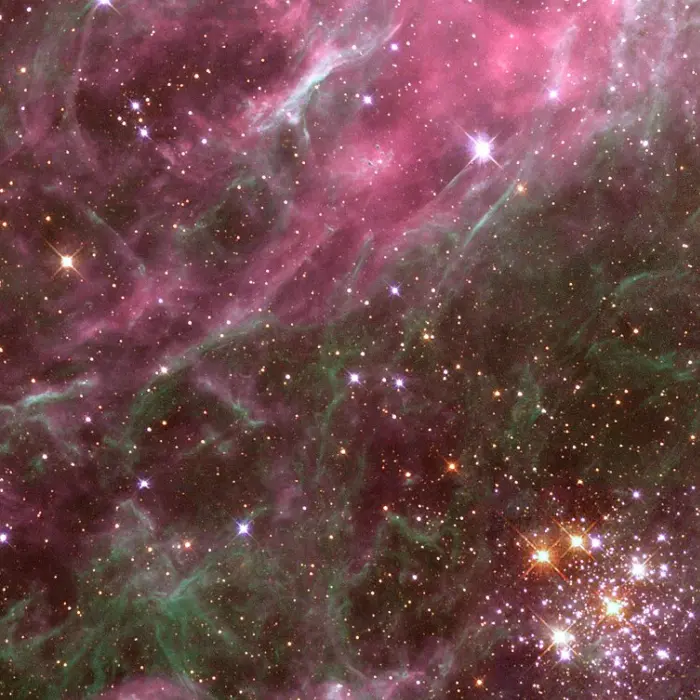
Part of the Tarantula Nebula, a giant HII region in the Large Magellanic Cloud. The star cluster at the lower right is Hodge 301. Image credit: The Hubble Heritage Team (AURA / STScI / NASA) (PD)
NGC 1850
NGC 1850 is a super star cluster located in the northwestern part of the LMC’s bar. It is embedded into the H II region Henize 103. It has an apparent magnitude of 9.0 and an apparent size of 3.4 arcseconds. The estimated age of the cluster is around 100 million years.
NGC 1850 is a double star cluster. It contains two main sequence populations. About a quarter of its members are hot, blue stars while the others are cool, red stars. The cluster has a total mass of around 41,700 solar masses and a radius of 16.2 light-years.
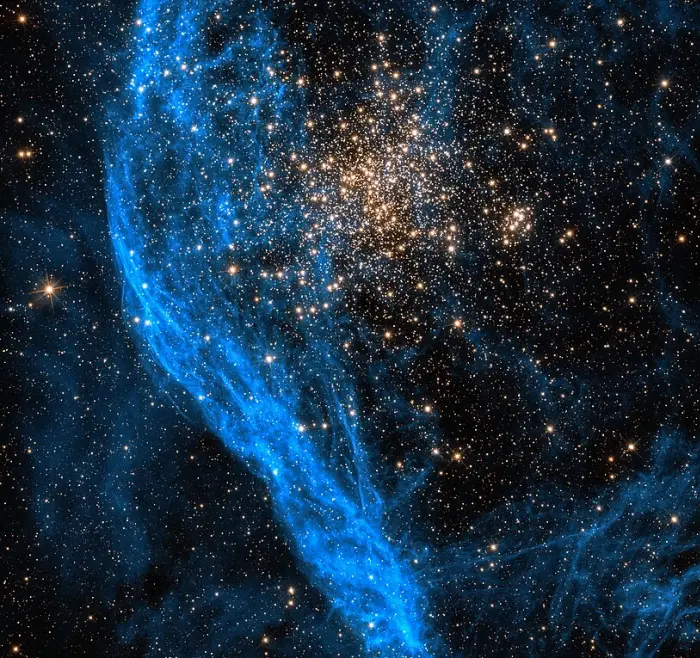
NGC 1850, image credit: NASA, ESA and P. Goudfrooij (Space Telescope Science Institute); Processing: Gladys Kober (NASA/Catholic University of America) (CC BY 2.0)
NGC 1872
NGC 1872 is an open star cluster with an apparent magnitude of 11.4 and an apparent size of 1 arcminute. Visually, it looks as rich and dense as a globular cluster, but its stars are much younger and bluer than those found in globular clusters.
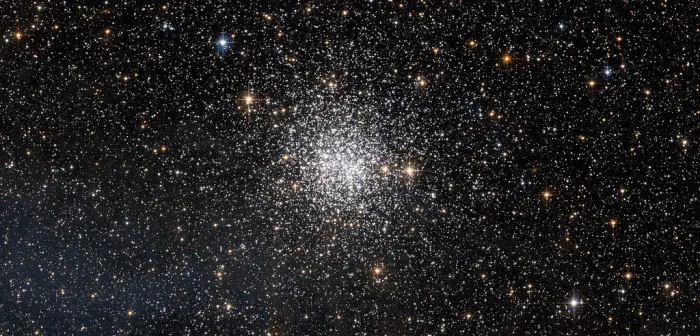
This spectacular NASA/ESA Hubble Space Telescope picture shows NGC 1872, a rich cluster of thousands of stars lying in our small neighbouring galaxy, the Large Magellanic Cloud. This little-studied cluster is located in the constellation of Dorado (the Dolphinfish, a fish unrelated to the dolphin and which often appears on dinner menus under its Hawaiian name mahi-mahi). The Scottish astronomer James Dunlop was probably the first to spot NGC 1872 in 1826 with a small telescope near Sydney in Australia. Image credit: ESA/Hubble and NASA (PD)
NGC 1858
NGC 1858 is a large but irregular open cluster with an apparent magnitude of 9.9. It is associated with the H II region LHA 120-N 105A (DEM L 86). The cluster has an estimated age of 8 million years. It is also catalogued as ESO 56-SC74 and Dunlop 120.
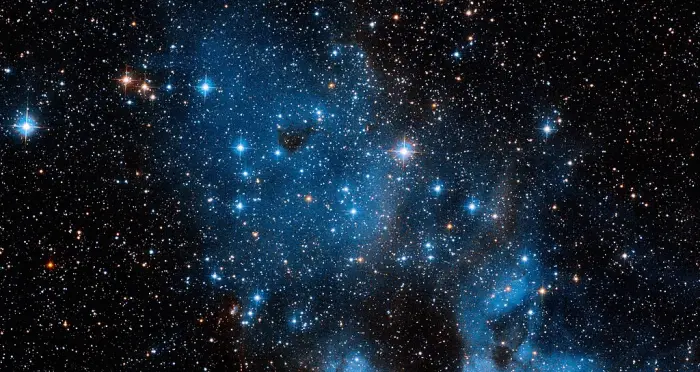
Against a backdrop littered with tiny pinpricks of light glint a few, brighter stars. This whole collection is NGC 1858, an open star cluster in the northwest region of the Large Magellanic Cloud, a satellite galaxy of our Milky Way that boasts an abundance of star-forming regions. NGC 1858 is estimated to be around 10 million years old. Image credit: NASA, ESA and G. Gilmore (University of Cambridge); Processing: Gladys Kober (NASA/Catholic University of America) (CC BY 2.0)
NGC 2164
NGC 2164 is a 10th magnitude open cluster in the Large Magellanic Cloud. It has an apparent size of 2.5 arcminutes. It was discovered by James Dunlop in 1826.
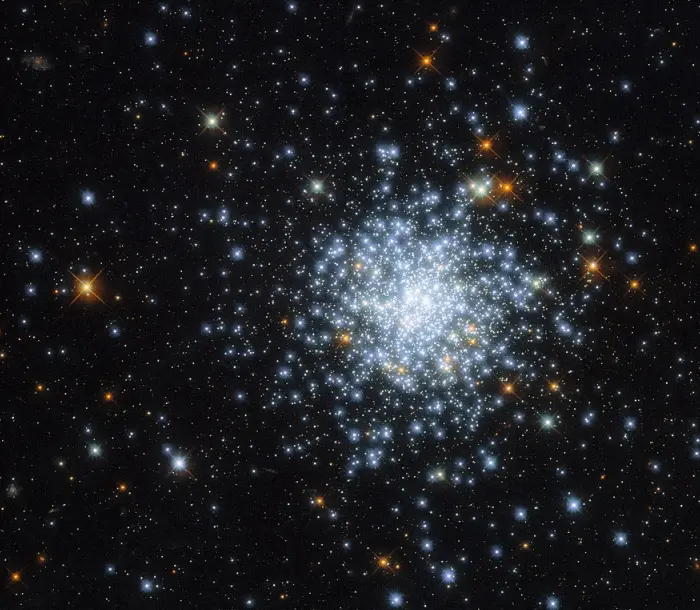
NGC 2164, image credit: ESA/Hubble & NASA, J. Kalirai, A. Milone (CC BY 4.0)
NGC 2002
NGC 2002 is an open cluster with an apparent magnitude of 10.1. It is 2 arcminutes across. Its brightest members appear near the centre while the fainter stars are further out. The cluster contains five red supergiants that stand out deep images. These evolved stars constrain the cluster’s age to 18 million years.
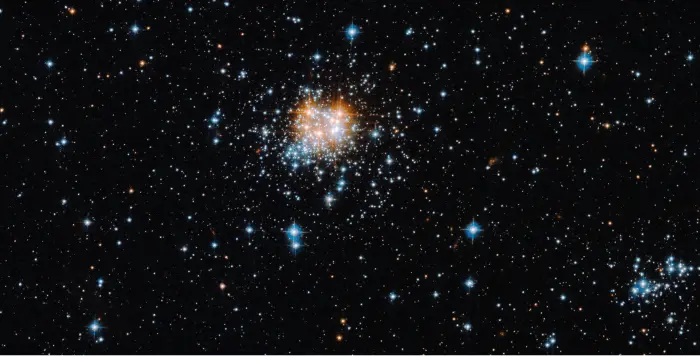
A twinkling group of stars dominates the center of this Hubble Space Telescope image. NGC 2002 is an open star cluster that resides roughly 160,000 light-years away from Earth in the Large Magellanic Cloud, a satellite galaxy of our Milky Way containing numerous star-forming regions. NGC 2002 is about 30 light-years in diameter and is a relatively young cluster at 18 million years old. Image credit: NASA, ESA and G. Gilmore (University of Cambridge); Processing: Gladys Kober (NASA/Catholic University of America) (CC BY 2.0)
NGC 1974
NGC 1974 is an open cluster associated with an emission nebula. It is also catalogued as NGC 1991. The cluster has an apparent size of 1.7 arcminutes and shines at magnitude 9.0.
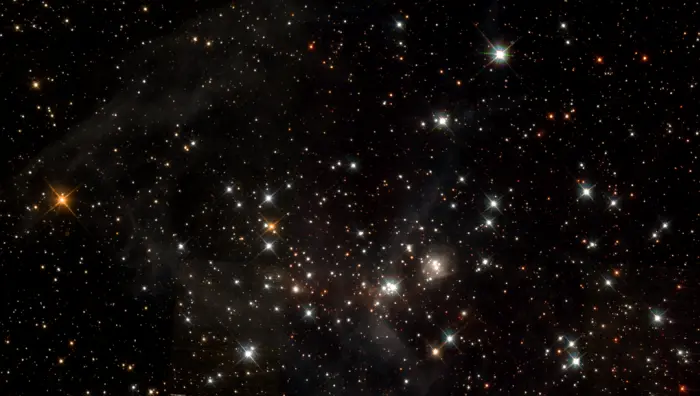
NGC 1974, image based on observations made with the NASA/ESA Hubble Space Telescope, and obtained from the Hubble Legacy Archive, which is a collaboration between the Space Telescope Science Institute (STScI/NASA), the Space Telescope European Coordinating Facility (ST-ECF/ESA) and the Canadian Astronomy Data Centre (CADC/NRC/CSA) (CC BY-SA 3.0)
NGC 1983
NGC 1983 is an open cluster with an apparent magnitude of 9.9 and an apparent size of 1 arcminute. Like many other star clusters in the LMC, it is associated with an emission nebula.
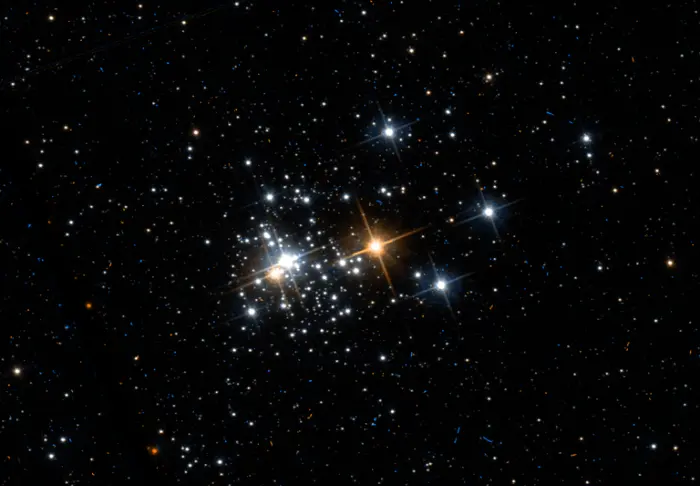
NGC 1983, image based on observations made with the NASA/ESA Hubble Space Telescope, and obtained from the Hubble Legacy Archive, which is a collaboration between the Space Telescope Science Institute (STScI/NASA), the Space Telescope European Coordinating Facility (ST-ECF/ESA) and the Canadian Astronomy Data Centre (CADC/NRC/CSA) (CC BY-SA 3.0)
NGC 1984
NGC 1984 is an open star cluster 1.5 by 1.2 arcminutes across. It has an apparent magnitude of 9.99 and is associated with an emission nebula.
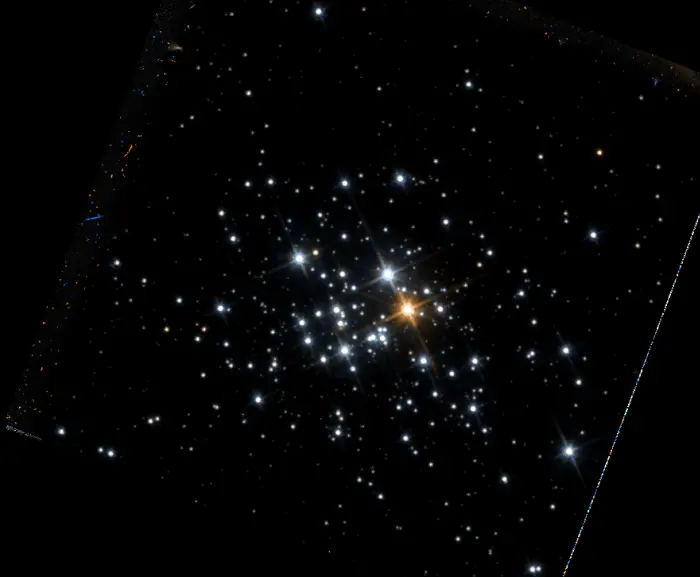
NGC 1984, image based on observations made with the NASA/ESA Hubble Space Telescope, and obtained from the Hubble Legacy Archive, which is a collaboration between the Space Telescope Science Institute (STScI/NASA), the Space Telescope European Coordinating Facility (ST-ECF/ESA) and the Canadian Astronomy Data Centre (CADC/NRC/CSA) (CC BY-SA 3.0)
Globular clusters
The Large Magellanic Cloud hosts at least 60 globular clusters. Many of them have been imaged by the Hubble Space Telescope. Unlike the globular clusters in the Milky Way, which are on average 10 billion years old, the globulars in the LMC are generally younger, with an age range of 5 million to 10 billion years. They are also more elliptical than those found in the Milky Way and Andromeda galaxies.
NGC 1783
NGC 1783 is one of the brightest and largest globular clusters in the Large Magellanic Cloud. It has an apparent magnitude of 10.39 and an apparent size of 5.3 by 4.7 arcseconds. It is believed to be 1.70 billion years old. The cluster has a mass of 98,000 Suns and a total luminosity of 377,000 Suns.
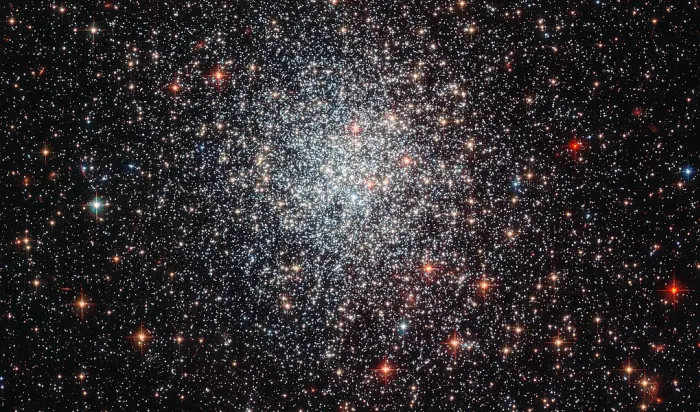
Shown here in a new image taken with the Advanced Camera for Surveys (ACS) on board the NASA/ESA Hubble Space Telescope, is the globular cluster NGC 1783. This is one of the biggest globular clusters in the Large Magellanic Cloud, a satellite galaxy of our own galaxy, the Milky Way, in the southern hemisphere constellation of Dorado. Image credit: ESA/Hubble & NASA; Acknowledgement: Judy Schmidt (geckzilla.com) (CC BY 4.0)
NGC 1866
The globular cluster NGC 1866 shines at magnitude 9.73 and is 5.50 arcseconds across. It was discovered by Scottish astronomer James Dunlop in August 1826.
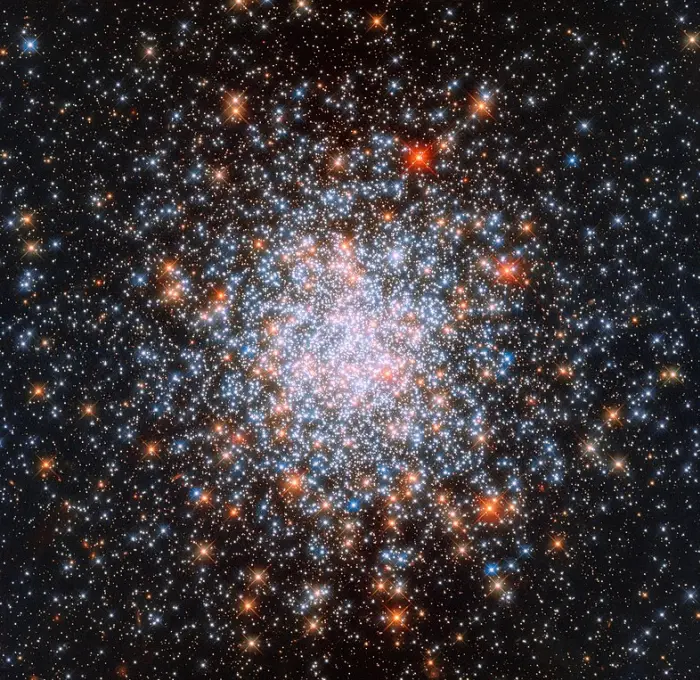
Star clusters are common structures throughout the Universe, each made up of hundreds of thousands of stars all bound together by gravity. This star-filled image, taken with the NASA/ESA Hubble Space Telescope’s Wide Field Camera 3 (WFC3), shows one of them: NGC 1866. Image: ESA/Hubble & NASA (CC BY 4.0)
NGC 1868
NGC 1868 is a metal-poor globular cluster with an apparent magnitude of 11.57. It contains many giant branch stars which have been used to constrain its age to around 700 million years. The cluster has an apparent size of 2.7 by 2.7 arcminutes.
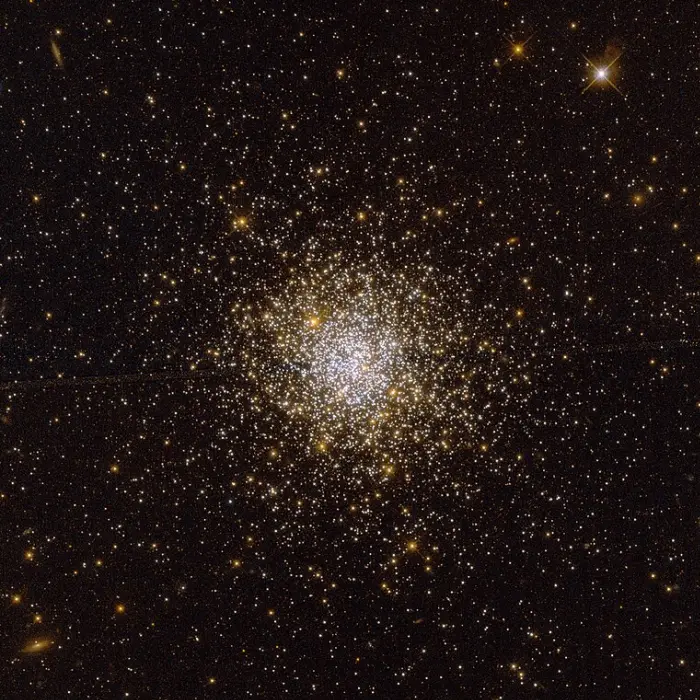
NGC 1868, image: NASA/ESA Hubble Space Telescope (CC BY-SA 4.0)
NGC 1854
NGC 1854 is a young globular cluster located near the emission nebula/open cluster NGC 1858. NGC 1854 has an apparent magnitude of 10.39 and lies 163,000 light-yeas away in the northern portion of the LMC’s central bar structure. It has an apparent size of 2.3 arcminutes.
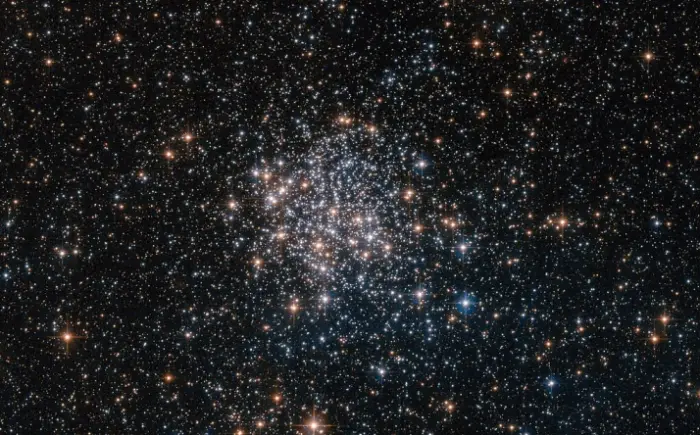
This NASA/ESA Hubble Space Telescope image shows the globular cluster NGC 1854, a gathering of white and blue stars in the southern constellation of Dorado. Image credit: ESA/Hubble & NASA (CC BY 4.0)
NGC 1898
NGC 1898 shines at magnitude 11.86 from a distance of 170,000 light-years. It has an apparent size of 1.60 arcminutes.
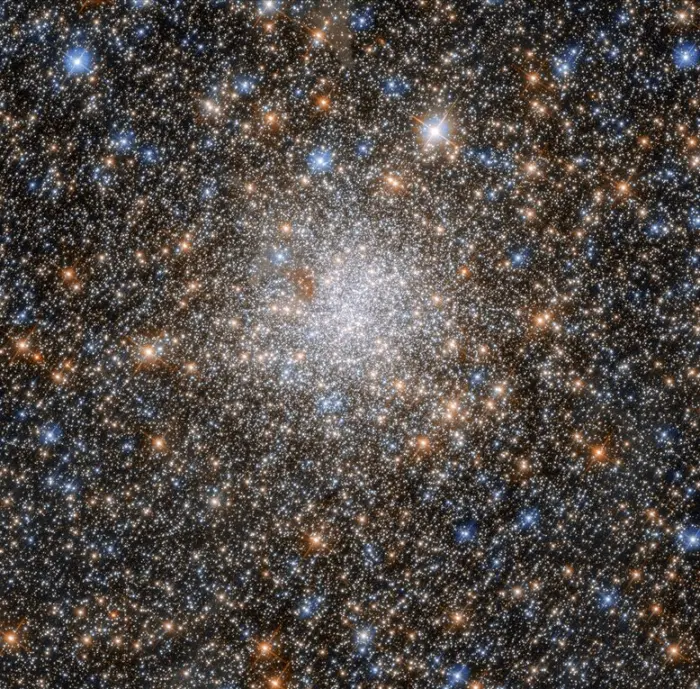
Discovered in November 1834 by British astronomer John Herschel, NGC 1898 has been scrutinised numerous times by the NASA/ESA Hubble Space Telescope. Today we know that globular clusters belong to the oldest known objects in the Universe and that they are relics of the first epochs of galaxy formation. Credit: European Space Agency (CC BY 2.0)
NGC 1818
NGC 1818 is a relatively bright globular cluster located 164,000 light-years away in the northwestern part of the LMC. It has an estimated age of 25-40 million years and a mass of 13,500 Suns.
NGC 1818 has a core radius of 8.7 light-years and a half-light radius of 45.1 light-years. It contains two distinct stellar populations: older, redder stars and younger, bluer ones. The cluster is a rare example of a very young globular. It is younger than many open clusters in the Milky Way, including the Pleiades and the Hyades.
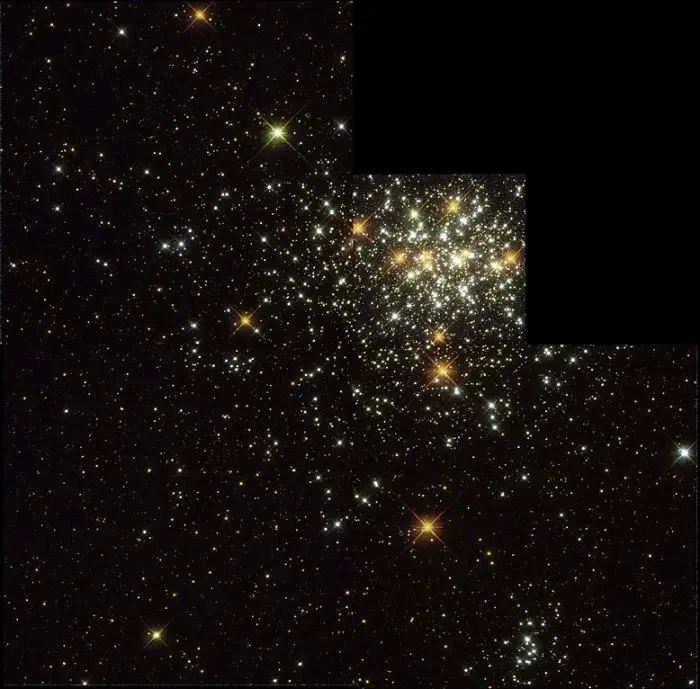
NGC 1818 by the Hubble Space Telescope, credit: ESA/NASA (PD)
NGC 1978
NGC 1978 is an elliptical globular cluster located 159,000 light-years away. It has an apparent magnitude of 10.12 and an apparent size of 10.7 by 3.9 arcminutes. It is believed to be 1.9 billion years old.
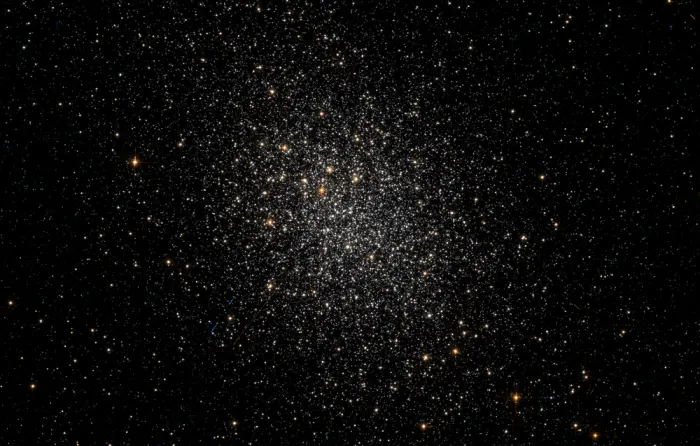
NGC 1978, image based on observations made with the NASA/ESA Hubble Space Telescope, and obtained from the Hubble Legacy Archive, which is a collaboration between the Space Telescope Science Institute (STScI/NASA), the Space Telescope European Coordinating Facility (ST-ECF/ESA) and the Canadian Astronomy Data Centre (CADC/NRC/CSA) (CC BY-SA 3.0)
NGC 1466
NGC 1466 is a globular cluster located in the outskirts of the Large Magellanic Cloud in the constellation Hydrus. The cluster lies 158,000 light-years away and has an apparent magnitude of 11.4. It is 3.50 arcminutes across. The estimated age of the cluster is 13.1 billion years.
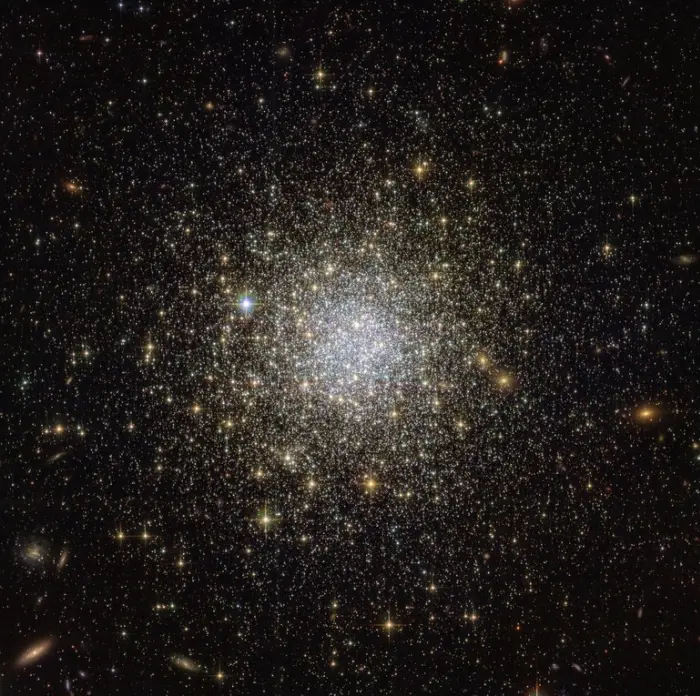
This image from the NASA/ESA Hubble Space Telescope reveals an ancient, glimmering ball of stars called NGC 1466. It is a globular cluster — a gathering of stars all held together by gravity — that is slowly moving through space on the outskirts of the Large Magellanic Cloud, one of our closest galactic neighbours. Image: ESA/Hubble & NASA (CC BY 4.0)
NGC 1846
The globular cluster NGC 1846 has an apparent magnitude of 10.68 and an apparent size of 3.8 arcminutes. It is around 1.7 billion years old. In images captured by the Hubble Space Telescope, a planetary nebula appears in the same line of sight as the cluster. The nebula’s central star is believed to be a member of NGC 1846.
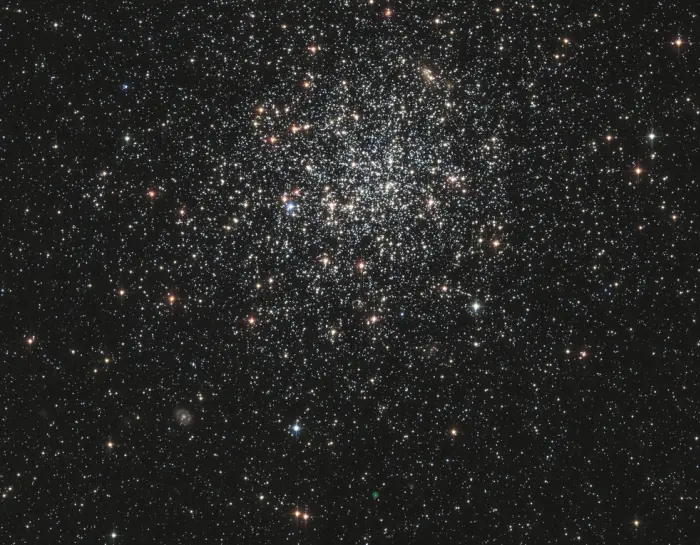
NGC 1846, image credit: NASA and The Hubble Heritage Team (STScI/AURA); Acknowledgment: P. Goudfrooij (STScI)
NGC 1806
NGC 1806 is a 1.6-billion-year-old globular cluster with an apparent magnitude of 11. It was discovered by John Herschel in 1836. It has an apparent size of 2.5 arcminutes.
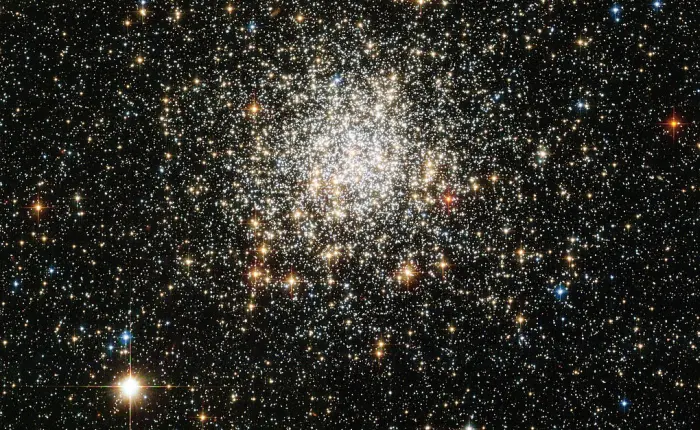
The NASA/ESA Hubble Space Telescope has turned its sharp eye towards a tight collection of stars, first seen 174 years ago. The result is a sparkling image of NGC 1806, tens of thousands of stars gravitationally bound into a rich cluster. Image credit: ESA/Hubble & NASA (CC BY 3.0)
NGC 2210
NGC 2210 is a dense globular cluster in the Large Magellanic Cloud. It has an estimated age of 11.6 billion years, similar to most globular clusters in the Milky Way. It was first captured by the Hubble Space Telescope in 2023.
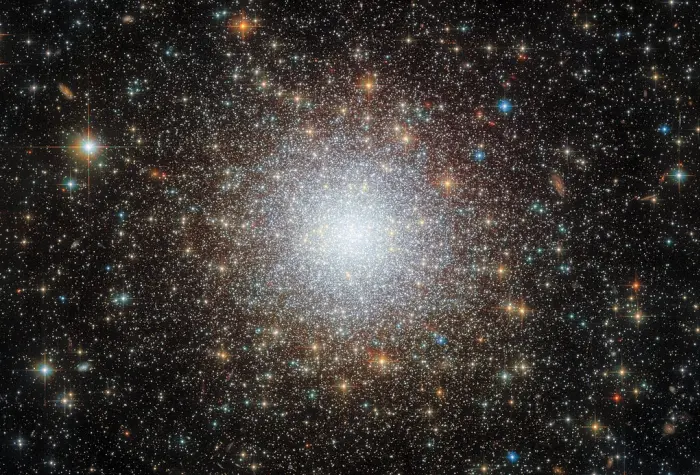
This striking image shows the densely packed globular cluster known as NGC 2210, which is situated in the Large Magellanic Cloud (LMC). Credit: ESA/Hubble & NASA, A. Sarajedini, F. Niederhofer (CC BY 4.0)
Facts
The Large and Small Magellanic Clouds are the only satellite galaxies of the Milky Way that are visible to the unaided eye. They are among the 61 small galaxies within 1.4 million light-years of our own galaxy. Not all these galaxies are confirmed Milky Way’s satellites.
In 2021, astronomers discovered a black hole with a mass of 11 solar masses in the LMC. They detected it using the European Southern Observatory’s Very Large Telescope (VLT) in the Atacama Desert of northern Chile. They were able to observe how the gravity of the black hole affected the motion of a nearby star with about 5 times the Sun’s mass. This was the first discovery of a black hole in a star cluster that is only about 100 million years old. The black hole was named NGC 1850 BH1, after its host cluster, NGC 1850.
In October 1968, the first discrete X-ray source was discovered in the LMC. The source stretched over about 12 degrees of the sky and corresponded to the galaxy.
X-ray sources in the galaxy include LMCX-1, a massive binary system, and the supernova remnant DEM L316. DEM L316 is in fact composed of two supernova remnants, one of a type Ia supernova and the other of a type II supernova.
In 1998, an ultra-fast pulsar, PSR J0537−6910, was discovered in the supernova remnant N157B (SNR 0538−69.1). At the time of discovery, the 16 ms pulsar was the fastest spinning pulsar associated with a supernova remnant.
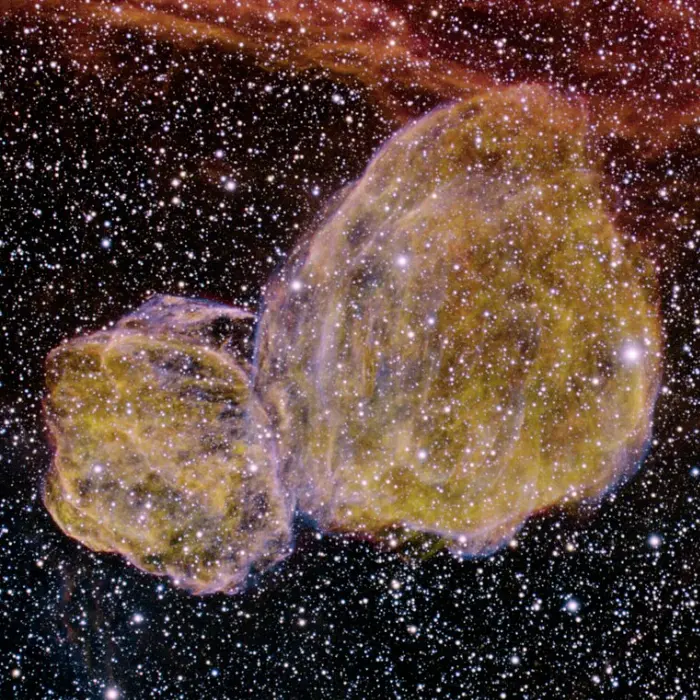
The Gemini South Multi-Object Spectrograph (GMOS) recently captured a dramatic image of a vast cloud complex named DEM L316 located in the Large Magellanic Cloud. The peanut-shaped nebula appears to be a single object, but the latest research indicates that it is really comprised of two distinct gas and dust clouds formed by different types of supernova events. Image credit: P. Michaud, S. Fisher, and R. Carrasco from Gemini and T. Rector from the Univ. of Alaska at Anchorage/International Gemini Observatory (CC BY 4.0)
Mythology
The Large Magellanic Cloud is too far south to be associated with any classical northern myths, but it has considerable cultural significance in countries in the southern hemisphere.
In Australian Aboriginal lore, the Large and Small Magellanic Clouds represented an old couple, the Jukara, cooking food over their campfire. The LMC represented the old man and the SMC his wife. The campfire was represented by the bright Achernar, the luminary of the constellation Eridanus.
The Large Magellanic Cloud partly lies in the constellation Mensa, which was named after the flat-topped Table Mountain in South Africa. (Mensa means “table” in Latin.) In South Africa, the LMC is associated with a puff of smoke from a pipe-smoking contest held on the mountain.
History
The Large Magellanic Cloud and the Small Magellanic Cloud have been known to observers in the southern hemisphere since prehistoric times.
The first known mention of the LMC was claimed to be by Persian astronomer Al Sufi (‘Abd al-Rahman al-Sufi Shirazi) in his Book of Fixed Stars (964 AD). Al Sufi called the object al-Bakr, meaning “the white ox” or “the sheep,” in a phrase meaning “the sheep of the southern Arabs.” However, this turned out to be a misunderstood reference to some stars south of Canopus in what was then the constellation Argo Navis. The Magellanic Clouds could not be seen from Al-Sufi’s observatory at Shiraz (29.6° N).
Amerigo Vespucci mentioned the object in a letter about his third voyage in 1503-1504. This was the first confirmed observation of the LMC and the SMC. In the letter, Vespucci describes “three Canopes, two bright and one obscure.” The “obscure” one referred to the Coalsack Nebula, a large dark nebula in the southern constellation Crux, and the “bright” ones to the Magellanic Clouds.
The first Europeans to observe the Magellanic Clouds were Italian explorers Peter Martyr d’Anghiera and Andrea Corsali in the late 15th century. Venetian scholar Antonio Pigafetta, who went on the Portuguese explorer Ferdinand Magellan’s expedition to circumnavigate the world from 1519 to 1522, also documented the objects.
Ferdinand Magellan is credited for bringing the Large Magellanic Cloud into common western knowledge, which is why the galaxy was later named after him. The LMC is mentioned in his writings describing his voyage in 1519. Magellan passed during that expedition in the Philippines, but his crew brought the record of the discovery back home to Europe.
However, the two galaxies did not get named after Magellan until much later. German astronomer Johann Bayer called them Nubecula Major and Nubecula Minor in his Uranometria (1603), and the French astronomer Lacaille called them le Grand Nuage and le Petit Nuage, meaning “the large cloud” and “the small cloud.”
The names of the Magellanic Clouds are controversial because Magellan did not discover the galaxies, and because accounts of his expeditions reflect his brutal treatment of the indigenous peoples he encountered. In 2023, a coalition of astronomers have called for the International Astronomical Union (IAU) to rename the galaxies.
The true nature of the Magellanic Clouds and other galaxies was only suspected before the 20th century. Their extragalactic nature was proven by American astronomer Edwin Hubble, who demonstrated that many objects that were until then classified as “nebulae” were in fact galaxies outside the Milky Way.
Hubble’s discovery was based on the work of American astronomer Henrietta Swan Leavitt, who discovered how to measure vast distances using Cepheid variables. The period-luminosity relationship of these stars is now known as Leavitt’s law.
Henrietta Swan Leavitt discovered 1,777 variable stars in the Large and Small Magellanic Clouds. Her report was published in 1908. The discovery allowed her to calculate the distance to the Small Magellanic Cloud.
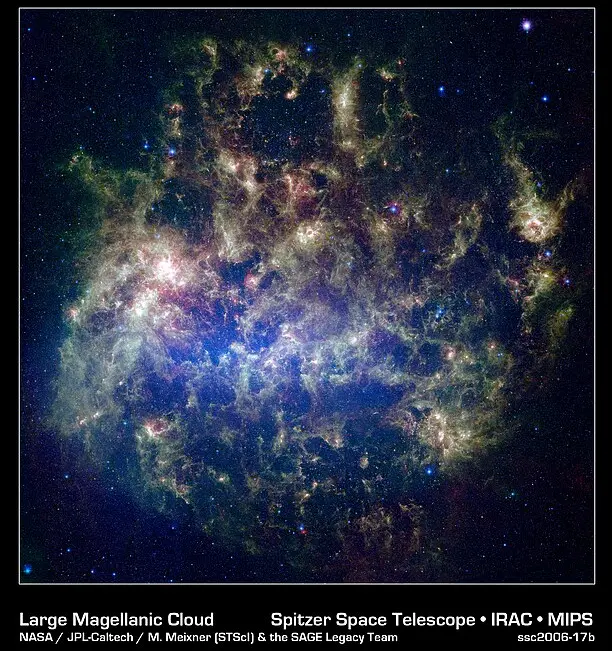
This vibrant image from NASA’s Spitzer Space Telescope shows the Large Magellanic Cloud, a satellite galaxy to our own Milky Way galaxy. The infrared image, a mosaic of 300,000 individual tiles, offers astronomers a unique chance to study the lifecycle of stars and dust in a single galaxy. Nearly one million objects are revealed for the first time in this Spitzer view, which represents about a 1,000-fold improvement in sensitivity over previous space-based missions. Most of the new objects are dusty stars of various ages populating the Large Magellanic Cloud; the rest are thought to be background galaxies. Credit: NASA/JPL-Caltech/M. Meixner (STScI) & the SAGE Legacy Team
Location
The Large Magellanic Cloud lies in the constellations Dorado and Mensa. These constellations are quite faint, but the galaxy can be easily found using Sirius and Canopus, the brightest stars in the sky. A line drawn from Sirius through Canopus points in the direction of the LMC.
With an apparent length of 10 degrees, about 20 times the apparent size of the full Moon, the galaxy is easy to spot from areas without light-pollution. It appears as a faint cloud.
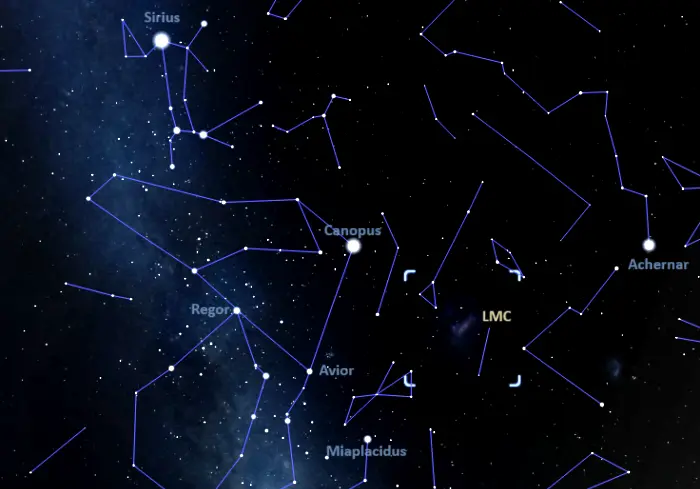
The location of the Large Magellanic Cloud, image: Stellarium
At declination -69°, the Large Magellanic Cloud is visible from locations south of the latitude 20° N. The galaxy is close enough to the south celestial pole to be circumpolar from much of the southern hemisphere.
The best time of the year to observe the Large Magellanic Cloud and other deep sky objects in the constellations Dorado and Mensa is during the month of January, when the constellations appear higher above the horizon in the early evening.
Large Magellanic Cloud
| Constellation | Dorado, Mensa |
| Object type | Magellanic spiral galaxy – SB(s)m |
| Right ascension | 05h 23m 34.6s |
| Declination | −69° 45′ 22′′ |
| Apparent magnitude | 0.13 |
| Apparent size | 10.75° × 9.17° |
| Size (diameter) | 32,200 light-years (9,860 parsecs) |
| Distance | 163,000 light-years (49.97 kiloparsecs) |
| Mass | 1×1010 M☉ (excluding dark matter), 1.38×1011 M☉ (including dark matter) |
| Number of stars | 20 billion |
| Names and designations | Large Magellanic Cloud, LMC, Nubecula Major, PGC 17223, ESO 56- G 115, IRAS 05240-6948 |